Paul van Yperen's Blog, page 255
October 25, 2018
Arnold Rieck
German humorist, couplet singer and actor Arnold Rieck (1876-1924) was a forerunner of the stand-up comedians of today. He was also one of the first stage actors who started to perform in films.

German postcard by Rotophot in the Film Sterne series, no. 185/4. Photo: Nicola Perscheid, Berlin / Messter Film, Berlin.

German postcard by Photochemie, no. K. 265. Photo: Alex Binder, Berlin.
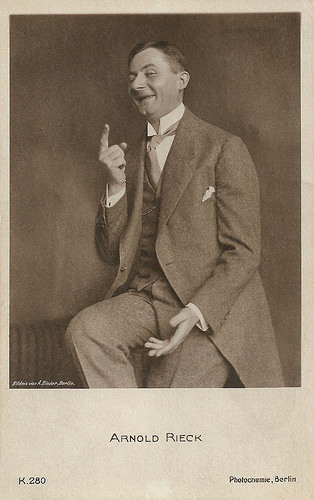
German postcard by Photochemie, no. K. 280. Photo: Alex Binder, Berlin.
A comedian against his will
Arnold Rieck was born in 1876 in Berlin. As a boy he always joined the gallery of the Royal Playhouse to see Hamlet or Romeo and Juliet.
He took acting lessons, but his slender height smashed his aspirations of becoming a tragic hero career and - against his will – he became a comedian. Rieck first made his name as a singer of couplets and as a solo entertainer with humorous antics. Thus he became the forerunner of the classic stand-up comedian.
In 1897 he made his stage debut in Gera. In 1899, the Berliner Operette was born at the Apollo Theatre and Rieck got the role of tailor Lämmermeyer in the new operetta Frau Luna (Ms. Luna) composed by Paul Lincke. The success was sensational.
And from then on, Rieck appeared on several metropolitan stages. His most successful period was as a star of the Berlin Thalia Theatre. There he could be seen in such popular comedies as Charleys Tante (Charley's aunt) and in the new Berlin operettas by composer Jean Gilbert.
According to himself, Arnold Rieck also was the first German stage actor, who moved over to the cinema. At the turn of the century, he appeared as the title figure in such short farces as Der Geck im Damenbade/The Dude in the ladies' bath and Piefke mit dem Floh/Piefke with the flea. Initially Rieck got a dozen plates per shooting day instead of payment. Later he received as a first fee 18 marks per day with a three-day shooting schedule.
At the Messter studio, he starred in such short comedies as Die fünf Sinne/The five senses (N.N., 1906) and Prinzess Rosine/Princess Rosine (N.N., 1907). The following year he appeared for the Duskes film studio in other comedy shorts like Prosit Neujahr 1909/Happy New Year 1909 (N.N.1908) with Emmy Wehlen, and Die Dollar-Prinzessin/The Dollar Princess (Alfred Duskes, 1908).
Next to Guido Thielscher, Leo Peukert and Guido Herzfeld, Rieck became one of the best known representatives of the early cinema farces. In 1910 he made for the Vitascope company in Berlin the military comedy short Es wär’ so schön gewesen/It would have been so nice (director unknown, 1910).

Arnold Rieck and Helene Ballot perform the song Essen wir mal Vielliebchen. German postcard by F.F. S. L.J., no. 2304/7, 1909. Caption: "Vielliebchen. Wer verliert nun lieber Schatz, Giebt dem Andern einen Schmatz, Und so wird uns nie zu viel, Das Vielliebchenspiel." (Philopena. Who now loses dear treasure, Give the other a smack, And so its never too much, The Many-lovers-game.) Essen wir mal Vielliebchen was a song from the operetta Mitternachtsmädchen by Victor Hollaender, first performed at the Odeon in Berlin in 1908.
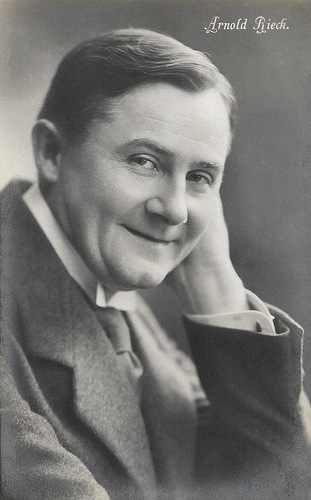
German postcard by NBC.
A stock stiff, comical type in an ancient costume
During the first World War, Arnold Rieck amused in numerous silent comedies as a stock stiff, comical type in an ancient costume. Successful examples are the comedies Musketier Kaczmarek/Musketeer Kaczmarek (Carl Froelich, 1915) with Ressel Orla , Der standhafte Benjamin/The staunch Benjamin (Robert Wiene, 1916) with Guido Herzfeld, and Brautfahrt/Lehmann's Honeymoon (Robert Wiene, 1916).
In the latter, he played a stiff gymnasium Professor of Greek history who dreams that he travels to antic Hellas and falls in love with a Greek beauty. In order to persuade the daydreaming Professor to marry his cousin, his family dress themselves up as Ancient Greeks.
With his high hat, roast skirt, umbrella and embroidered travel bag, Rieck reminded his public of long outdated times, and he was not afraid to ridicule himself.
Shortly after the war, his type of humour felt outdated and Rieck was replaced by more subtle comedians. American stars such as Charles Chaplin and Buster Keaton now dominated the German screens.
In the 1920s Rieck refocused on his stage career and worked as a humorist at Berlin's Komische Oper and the new Operetta Theater in Leipzig.
In 1924, Arnold Rieck collapsed on stage in Leipzig and died unexpectedly, only 48 years old. His final film appearance had been a supporting role in the Henny Porten drama Mutter und Kind/Mother and Child (Carl Froelich, 1924). Sound recordings of the comedian have survived on gramophone and Zonophon records and Edison cylinders.
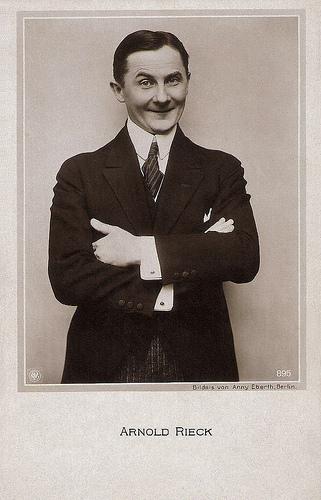
German postcard by NPG, no. 895. Photo: Anny Eberth, Berlin.
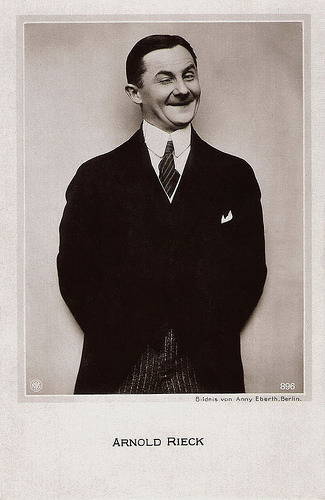
German postcard by NPG, no. 896. Photo: Anny Eberth, Berlin.
Sources: Gerold Ducke (Die Geschichte Berlins – German), Wikipedia (German and English) and .

German postcard by Rotophot in the Film Sterne series, no. 185/4. Photo: Nicola Perscheid, Berlin / Messter Film, Berlin.

German postcard by Photochemie, no. K. 265. Photo: Alex Binder, Berlin.

German postcard by Photochemie, no. K. 280. Photo: Alex Binder, Berlin.
A comedian against his will
Arnold Rieck was born in 1876 in Berlin. As a boy he always joined the gallery of the Royal Playhouse to see Hamlet or Romeo and Juliet.
He took acting lessons, but his slender height smashed his aspirations of becoming a tragic hero career and - against his will – he became a comedian. Rieck first made his name as a singer of couplets and as a solo entertainer with humorous antics. Thus he became the forerunner of the classic stand-up comedian.
In 1897 he made his stage debut in Gera. In 1899, the Berliner Operette was born at the Apollo Theatre and Rieck got the role of tailor Lämmermeyer in the new operetta Frau Luna (Ms. Luna) composed by Paul Lincke. The success was sensational.
And from then on, Rieck appeared on several metropolitan stages. His most successful period was as a star of the Berlin Thalia Theatre. There he could be seen in such popular comedies as Charleys Tante (Charley's aunt) and in the new Berlin operettas by composer Jean Gilbert.
According to himself, Arnold Rieck also was the first German stage actor, who moved over to the cinema. At the turn of the century, he appeared as the title figure in such short farces as Der Geck im Damenbade/The Dude in the ladies' bath and Piefke mit dem Floh/Piefke with the flea. Initially Rieck got a dozen plates per shooting day instead of payment. Later he received as a first fee 18 marks per day with a three-day shooting schedule.
At the Messter studio, he starred in such short comedies as Die fünf Sinne/The five senses (N.N., 1906) and Prinzess Rosine/Princess Rosine (N.N., 1907). The following year he appeared for the Duskes film studio in other comedy shorts like Prosit Neujahr 1909/Happy New Year 1909 (N.N.1908) with Emmy Wehlen, and Die Dollar-Prinzessin/The Dollar Princess (Alfred Duskes, 1908).
Next to Guido Thielscher, Leo Peukert and Guido Herzfeld, Rieck became one of the best known representatives of the early cinema farces. In 1910 he made for the Vitascope company in Berlin the military comedy short Es wär’ so schön gewesen/It would have been so nice (director unknown, 1910).

Arnold Rieck and Helene Ballot perform the song Essen wir mal Vielliebchen. German postcard by F.F. S. L.J., no. 2304/7, 1909. Caption: "Vielliebchen. Wer verliert nun lieber Schatz, Giebt dem Andern einen Schmatz, Und so wird uns nie zu viel, Das Vielliebchenspiel." (Philopena. Who now loses dear treasure, Give the other a smack, And so its never too much, The Many-lovers-game.) Essen wir mal Vielliebchen was a song from the operetta Mitternachtsmädchen by Victor Hollaender, first performed at the Odeon in Berlin in 1908.

German postcard by NBC.
A stock stiff, comical type in an ancient costume
During the first World War, Arnold Rieck amused in numerous silent comedies as a stock stiff, comical type in an ancient costume. Successful examples are the comedies Musketier Kaczmarek/Musketeer Kaczmarek (Carl Froelich, 1915) with Ressel Orla , Der standhafte Benjamin/The staunch Benjamin (Robert Wiene, 1916) with Guido Herzfeld, and Brautfahrt/Lehmann's Honeymoon (Robert Wiene, 1916).
In the latter, he played a stiff gymnasium Professor of Greek history who dreams that he travels to antic Hellas and falls in love with a Greek beauty. In order to persuade the daydreaming Professor to marry his cousin, his family dress themselves up as Ancient Greeks.
With his high hat, roast skirt, umbrella and embroidered travel bag, Rieck reminded his public of long outdated times, and he was not afraid to ridicule himself.
Shortly after the war, his type of humour felt outdated and Rieck was replaced by more subtle comedians. American stars such as Charles Chaplin and Buster Keaton now dominated the German screens.
In the 1920s Rieck refocused on his stage career and worked as a humorist at Berlin's Komische Oper and the new Operetta Theater in Leipzig.
In 1924, Arnold Rieck collapsed on stage in Leipzig and died unexpectedly, only 48 years old. His final film appearance had been a supporting role in the Henny Porten drama Mutter und Kind/Mother and Child (Carl Froelich, 1924). Sound recordings of the comedian have survived on gramophone and Zonophon records and Edison cylinders.

German postcard by NPG, no. 895. Photo: Anny Eberth, Berlin.

German postcard by NPG, no. 896. Photo: Anny Eberth, Berlin.
Sources: Gerold Ducke (Die Geschichte Berlins – German), Wikipedia (German and English) and .
Published on October 25, 2018 22:00
October 24, 2018
Dvije sirotice (1919)
Dvije sirote/Dvije sirotice/The Two Orphans is a silent film, made in the former Kingdom of Serbs, Croatians and Slovenes, now Croatia. The film, directed by Alfred Grinhut a.k.a. Alfred Grünhut, was produced in 1918 by Croatia Film and distributed in 1919 by Jugoslavija Film in Zagreb. The film is considered lost. The rare, sepia postcards used for this post are from the collection of Ivo Blom. The film was based on the famous French play Les deux orphelines by Adolphe d'Ennery and Eugène Cormon (1874), which was adapted many times for film - the most famous one being D.W. Griffith's version Orphans of the Storm (1921). Dvije sirote stars Zorka Grund, playing both orphans. Other actors are Zorka's father Arnošt Grund, August Cilić, Ervin Vilković, and director Alfred Grünhut.
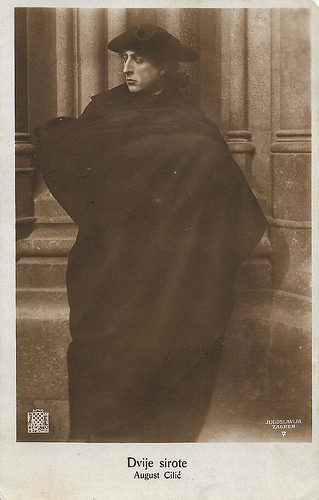
Former Kingdom of Serbs, Croatians and Slovenes (now Croatian) postcard by Jugoslavija Film, Zagreb, no. 7. August Cilić in Dvije sirote/Dvije sirotice/The Two Orphans (Alfred Grinhut a.k.a. Alfred Grünhut, 1919).
August Cilić (1891-1963), was a Croatian actor, comedian and director of the Croatian National Theatre in Zagreb, and the Croatian National Theatre in Varaždin.
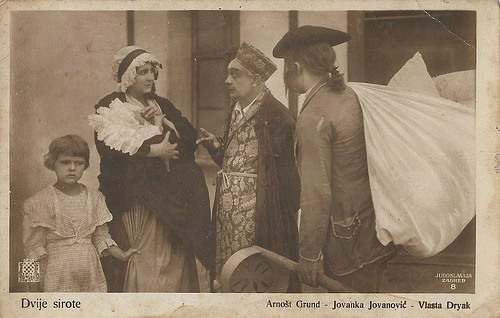
Former Kingdom of Yugoslavia (now Croatian) postcards by Jugoslavija Film, Zagreb, no. 8. Arnošt Grund, Jovanka Jovanovic and Vlasta Dryak in Dvije sirote/Dvije sirotice/The Two Orphans (Alfred Grinhut a.k.a. Alfred Grünhut, 1919).
Tenor and actor Arnošt Grund (1866-1929) was born and educated in Prague. In 1895, Stjepan Miletić brought him to Zagreb. There, he fell in love with Croatian art, and remained in Zagreb until his death. Grund was a pioneer of the Croatian cinema, working as actor, screenwriter and director. Jovanka (Ivanka) Jovanović (born Dvorniković) (1887-1963) was a Serbian-Croatian actress. Vlasta Dryak (1911-2006) must have been just a child of 7 or 8 when she played in Dvije sirote. When she was 21 she became a stage actress and was successful at the Croatian National Theatre.
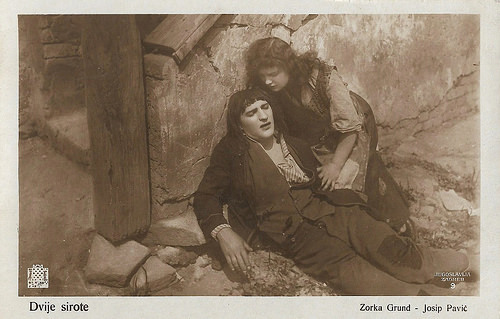
Former Kingdom of Yugoslavia (now Croatian) postcards by Jugoslavija Film, Zagreb, no. 9. Zorka Grund and Josip Pavic in in Dvije sirote/Dvije sirotice/The Two Orphans (Alfred Grinhut a.k.a. Alfred Grünhut, 1919).
Zorka Kremzar, born Zorka Grund (1900-?), was a Croatian film actress. She was the daughter of Arnošt Grund, a director of the Czech origin, and sister of Milada Grund, who performed under the pseudonym of Milada Tana. Zorka Grund later became a filmmaker, according to Croatian sources.
Josip Pavic (1887-1936), born in Trasnik (Bosnia and Herzegovina) was a stage actor, primarily performing at the Croatian National Theatre in Zagreb, Croatia, where his bronze bust is featured in the grand hall. While he was a renowned actor in many roles, his most famous role was as Hamlet. With other actors, he helped to build the 2nd instalment of the National Theatre, located in Split, Croatia. In 1919 Pavic acted in five silent films, among which Dvije sirote and Vragoljanka. In 1936 Pavic died in Zagreb from cirrhosis of the liver and heart failure. His funeral was attended by hundreds of his fans.
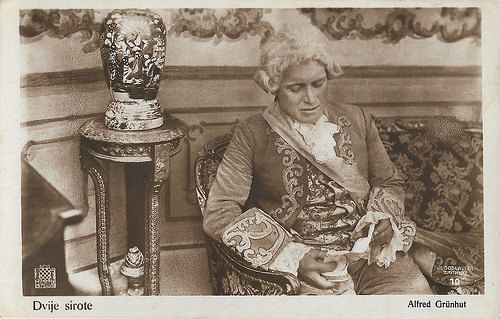
Former Kingdom of Yugoslavia (now Croatian) postcards by Jugoslavija Film, Zagreb, no. 10. Alfred Grünhut in Dvije sirote/Dvije sirotice/The Two Orphans (Alfred Grinhut a.k.a. Alfred Grünhut, 1919).
Alfred Grinhut or Alfred Grünhut (1882-1946) was a Croatian and Yugoslav actor and director, known as the author of two films lost today: Vragoljanka (1919) and Dvije sirote (1919), in which he also acted. He also acted in Brisem i sudim (Arnost Grund, 1919) and Dvorovi u samoci (Tito Strozzi, 1925) too.
The first Croatian film companies
As Croatian film historian Dejan Kosanovic indicates in his study Kinematografija i film i Kraljevini SHS/Kraljevini Jugoslaviji 1918-1941 (2011), domestic film production in Croatia started during the First World War.
In 1917, Hamilkar Bošković and Julien Bergmann founded the first Croatian film company, Croatia. They engaged Croatian actors and directors and Austrian technicians. The first Croatian film director was Joseph Halle, who made most of the films of the Croatia company. At the end of 1918 Bošković and Bergmann sold their rights to the new company Hermes or New Croatia, which was active until 1920.
Early 1919, Hamilkar Boskovic founded with Theodore Milic the company Jugoslavija Film. April 1919 Milic was in Paris and bought Pathé cameras and equipment. Among the film company members were three actors of the National Theatre, Alfred Grünhut, Tito Marquis Strozzi and Dragutin Horvat. Alfred Grünhut (1882-1946) had already directed two films and played in several other films of the former Croatia film company.
The first and very ambitious project of Jugoslavija Film was the film Brišem i sudim/B. and the judge, a grand melodrama for which the scenario was written in Slovenian and Croatian by theatre actor and director Ignjat (Ignatius) Borštnik (1858-1919), who also played the main role in the film. The director was Arnošt Grund (1866-1929), a Czech theatre actor and director who lived and worked in Zagreb since 1895, while the cameraman was one of the pioneers of the Austrian film Ljudevit Šašek (Ludwig Schaschek).
The scenographer for Brišem i sudim/B. and the judge was the Zagreb painter Otto Antonini (1849-1937), whom Jugoslavija engaged as a painter of sets and props. He also painted the decorations for film posters and for interiors in the films, and he produced the trademark of the company - three girls holding the coats of arms of Serbs, Croats and Slovenes.
As Brišem i sudim was successful, soon more films of Jugoslavija followed, such as Jeftina košta (Arnost Grund, 1919), based on a script by Grund and filmed by Schaschek, and U lavljem kavezu (1919), scripted and directed by Arnošt Grund. Jugoslavaija also distributed films by others, such as those by the Austrian company Sascha-Film.

Former Kingdom of Yugoslavia (now Croatian) postcards by Jugoslavija Film, Zagreb, no. 11. Milica Mihicic, Zorka Grund and Bogumila Vilhar in Dvije sirote/Dvije sirotice/The Two Orphans (Alfred Grinhut a.k.a. Alfred Grünhut, 1919).
Bogumila Vilhar (1882-1962) was a Croatian stage and screen actress. From 1905, she continuously acted at the Croatian National Theatre, apart from breaks at Osijek (1919-1921) and Split (1922-1924). She played in Shakespeare and Schiller classics and also in many plays by domestic authors. Vilhar is also known for the film Lisinski (Oktavijan Miletic, 1944), a biopic of Croatian composer Vatroslav Lisinski.
Milica Mihičić (1864-1950) first appeared on stage in 1890 in Zagreb, where she acted as an extraordinary actress for the following 50 years. At the beginning of her career she performed in various roles in dramas, ballet and operettas. She continued as an actress in French Salon prose theatre. Her second vocation was the psychological realistic drama. Mihičić appeared also in the film Dama sa crnom krinkom/The Lady with the Black Curse (1919).
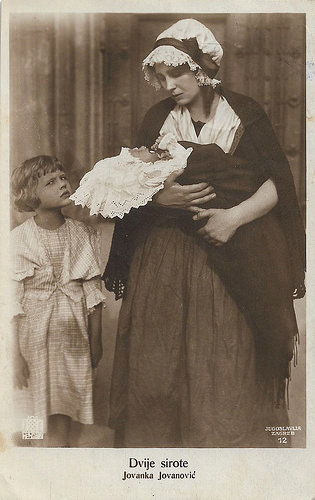
Former Kingdom of Yugoslavia (now Croatian) postcards by Jugoslavija Film, Zagreb, no. 12. Jovanka Jovanovic and Vlasta Dryak in Dvije sirote/Dvije sirotice/The Two Orphans (Alfred Grinhut a.k.a. Alfred Grünhut, 1919).
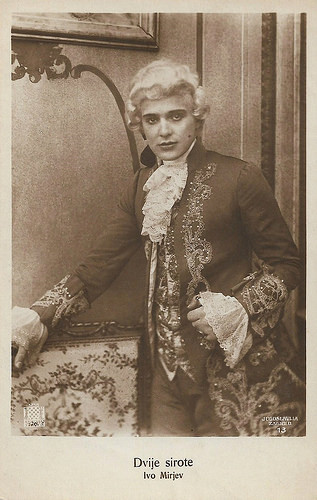
Former Kingdom of Serbs, Croatians and Slovenes postcard by Jugoslavija Film, Zagreb, no. 13. Ivo Mirjev in Dvije sirote/Dvije sirotice/The Two Orphans (Alfred Grünhut, 1919).
Ivo Mirjev aka Ivan Mirjev and Ivan de Dominis-Mirjev (1894-1967) was a Croatian actor and theatre director.
Passion for adventure
Dvije sirote/The Two Orphans (Alfred Grünhut, 1919) is based on the 1874 French play Les deux orphelines and situated in the eighteenth century, shortly before the French Revolution. The orphan Henriette Gerard accompanies Louise, her blind adoptive sister, to Paris. The two girls hope to find a doctor who will cure Louise of her blindness. On the basis of the postcards, it seems that Zorka Grund played both Louise and Henriette.
Henriette is kidnapped by the Marquis de Presles, a rogue who decides to make her his toy. Louise is no more fortunate than her sister: left to herself, she falls into the hands of Madame Frochard, an alcoholic shrew who will constantly humiliate and torment her to force her to beg by singing in the streets.
The kind Chevalier de Vaudry in vain tries to help Henriette to find Louise again. Henriette is imprisoned, while Louise suffers equally on the streets, only helped by Pierre. The outbreak of the French Revolution aggravates the situation, and Henriette and Vaudry risk to die under he guillotine. In the end all will be saved: Louise will cured from her blindness, while Henriette can marry Vaudry.
During only two years, 1919 and 1920, Jugoslavija produced 9 documentaries films, 11 special issues and 5 feature films, but apparently faced financial difficulties, so it transformed into a joint stock company in order to attract more stockholders and increase capital. The two founders were replaced by Marcel Kolin. He expanded the company, opened offices in Split and Belgrade (1922), and even a film academy (also 1922).
However, Jugoslavija's sixth and last feature film was Strast za pustolovinama/Passion for adventure (1922) by the Russian director Aleksandar Aleksandrovič Vereščagin and scripted possibly by Josip Halle. Local distributors and cinema owners by then were more interested in foreign films. The shareholders of Jugoslavija backed out in 1922, so the company went bankrupt in 1923. Without help of the state, the young Croatian cinema petered out.
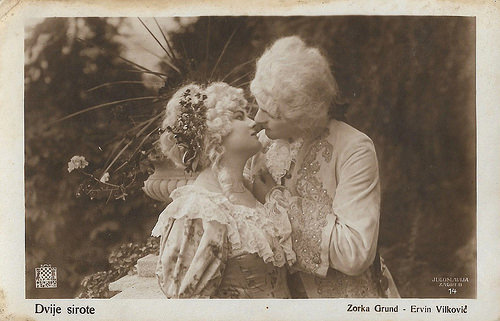
Former Kingdom of Serbs, Croatians and Slovenes postcard by Jugoslavija Film, Zagreb, no. 14. Zorka Grund in Dvije sirote/Dvije sirotice/The Two Orphans (Alfred Grünhut, 1919).
Zorka Kremzar, born Zorka Grund (1900-?), was a Croatian film actress. She was the daughter of Arnošt Grund, a director of the Czech origin, and sister of Milada Grund, who performed under the pseudonym of Milada Tana. Zorka Grund later became a filmmaker.
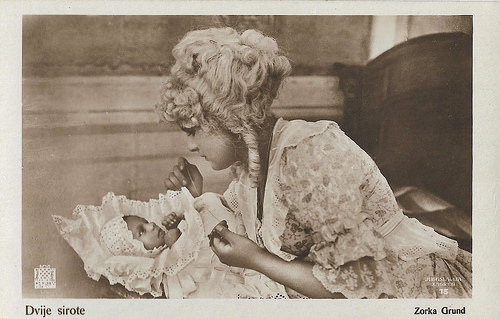
Former Kingdom of Serbs, Croatians and Slovenes postcard by Jugoslavija Film, Zagreb, no. 15. Zorka Grund in Dvije sirote/Dvije sirotice/The Two Orphans (Alfred Grünhut, 1919).
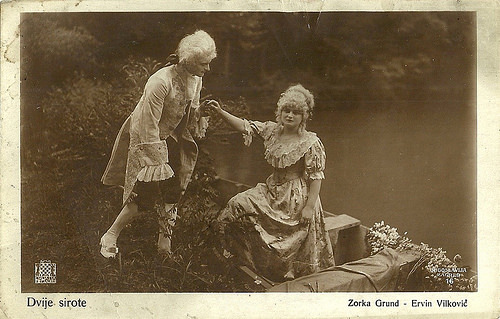
Former Kingdom of Serbs, Croatians and Slovenes postcard by Jugoslavija Film, Zagreb, no. 16. Zorka Grund and Ervin Vilkovic in Dvije sirote/Dvije sirotice/The Two Orphans (Alfred Grünhut, 1919).

Former Kingdom of Serbs, Croatians and Slovenes postcard by Jugoslavija Film, Zagreb, no. 17. Franjo Stosek and Josip Horvat in Dvije sirote/Dvije sirotice/The Two Orphans (Alfred Grünhut, 1919).
Franjo Sotošek (1881-1945) was a Croatian actor. Under the pseudonym Franjo André he performed at the Zagreb National Theatre (1899-1900), then in the traveling company of D. Freudenreich. Between 1904 and 1938 he was a member of the Zagreb National Theatre.
Sources: Dejan Kosanovic (Kinematograija a i film u kraljevini shs/kraljevini Jugosviji 1918-1941 - Croatian), Mirror mmg, Hrvatska Enciclopedija (Croatian), Wikipedia (Croatian) and IMDb.

Former Kingdom of Serbs, Croatians and Slovenes (now Croatian) postcard by Jugoslavija Film, Zagreb, no. 7. August Cilić in Dvije sirote/Dvije sirotice/The Two Orphans (Alfred Grinhut a.k.a. Alfred Grünhut, 1919).
August Cilić (1891-1963), was a Croatian actor, comedian and director of the Croatian National Theatre in Zagreb, and the Croatian National Theatre in Varaždin.

Former Kingdom of Yugoslavia (now Croatian) postcards by Jugoslavija Film, Zagreb, no. 8. Arnošt Grund, Jovanka Jovanovic and Vlasta Dryak in Dvije sirote/Dvije sirotice/The Two Orphans (Alfred Grinhut a.k.a. Alfred Grünhut, 1919).
Tenor and actor Arnošt Grund (1866-1929) was born and educated in Prague. In 1895, Stjepan Miletić brought him to Zagreb. There, he fell in love with Croatian art, and remained in Zagreb until his death. Grund was a pioneer of the Croatian cinema, working as actor, screenwriter and director. Jovanka (Ivanka) Jovanović (born Dvorniković) (1887-1963) was a Serbian-Croatian actress. Vlasta Dryak (1911-2006) must have been just a child of 7 or 8 when she played in Dvije sirote. When she was 21 she became a stage actress and was successful at the Croatian National Theatre.

Former Kingdom of Yugoslavia (now Croatian) postcards by Jugoslavija Film, Zagreb, no. 9. Zorka Grund and Josip Pavic in in Dvije sirote/Dvije sirotice/The Two Orphans (Alfred Grinhut a.k.a. Alfred Grünhut, 1919).
Zorka Kremzar, born Zorka Grund (1900-?), was a Croatian film actress. She was the daughter of Arnošt Grund, a director of the Czech origin, and sister of Milada Grund, who performed under the pseudonym of Milada Tana. Zorka Grund later became a filmmaker, according to Croatian sources.
Josip Pavic (1887-1936), born in Trasnik (Bosnia and Herzegovina) was a stage actor, primarily performing at the Croatian National Theatre in Zagreb, Croatia, where his bronze bust is featured in the grand hall. While he was a renowned actor in many roles, his most famous role was as Hamlet. With other actors, he helped to build the 2nd instalment of the National Theatre, located in Split, Croatia. In 1919 Pavic acted in five silent films, among which Dvije sirote and Vragoljanka. In 1936 Pavic died in Zagreb from cirrhosis of the liver and heart failure. His funeral was attended by hundreds of his fans.

Former Kingdom of Yugoslavia (now Croatian) postcards by Jugoslavija Film, Zagreb, no. 10. Alfred Grünhut in Dvije sirote/Dvije sirotice/The Two Orphans (Alfred Grinhut a.k.a. Alfred Grünhut, 1919).
Alfred Grinhut or Alfred Grünhut (1882-1946) was a Croatian and Yugoslav actor and director, known as the author of two films lost today: Vragoljanka (1919) and Dvije sirote (1919), in which he also acted. He also acted in Brisem i sudim (Arnost Grund, 1919) and Dvorovi u samoci (Tito Strozzi, 1925) too.
The first Croatian film companies
As Croatian film historian Dejan Kosanovic indicates in his study Kinematografija i film i Kraljevini SHS/Kraljevini Jugoslaviji 1918-1941 (2011), domestic film production in Croatia started during the First World War.
In 1917, Hamilkar Bošković and Julien Bergmann founded the first Croatian film company, Croatia. They engaged Croatian actors and directors and Austrian technicians. The first Croatian film director was Joseph Halle, who made most of the films of the Croatia company. At the end of 1918 Bošković and Bergmann sold their rights to the new company Hermes or New Croatia, which was active until 1920.
Early 1919, Hamilkar Boskovic founded with Theodore Milic the company Jugoslavija Film. April 1919 Milic was in Paris and bought Pathé cameras and equipment. Among the film company members were three actors of the National Theatre, Alfred Grünhut, Tito Marquis Strozzi and Dragutin Horvat. Alfred Grünhut (1882-1946) had already directed two films and played in several other films of the former Croatia film company.
The first and very ambitious project of Jugoslavija Film was the film Brišem i sudim/B. and the judge, a grand melodrama for which the scenario was written in Slovenian and Croatian by theatre actor and director Ignjat (Ignatius) Borštnik (1858-1919), who also played the main role in the film. The director was Arnošt Grund (1866-1929), a Czech theatre actor and director who lived and worked in Zagreb since 1895, while the cameraman was one of the pioneers of the Austrian film Ljudevit Šašek (Ludwig Schaschek).
The scenographer for Brišem i sudim/B. and the judge was the Zagreb painter Otto Antonini (1849-1937), whom Jugoslavija engaged as a painter of sets and props. He also painted the decorations for film posters and for interiors in the films, and he produced the trademark of the company - three girls holding the coats of arms of Serbs, Croats and Slovenes.
As Brišem i sudim was successful, soon more films of Jugoslavija followed, such as Jeftina košta (Arnost Grund, 1919), based on a script by Grund and filmed by Schaschek, and U lavljem kavezu (1919), scripted and directed by Arnošt Grund. Jugoslavaija also distributed films by others, such as those by the Austrian company Sascha-Film.

Former Kingdom of Yugoslavia (now Croatian) postcards by Jugoslavija Film, Zagreb, no. 11. Milica Mihicic, Zorka Grund and Bogumila Vilhar in Dvije sirote/Dvije sirotice/The Two Orphans (Alfred Grinhut a.k.a. Alfred Grünhut, 1919).
Bogumila Vilhar (1882-1962) was a Croatian stage and screen actress. From 1905, she continuously acted at the Croatian National Theatre, apart from breaks at Osijek (1919-1921) and Split (1922-1924). She played in Shakespeare and Schiller classics and also in many plays by domestic authors. Vilhar is also known for the film Lisinski (Oktavijan Miletic, 1944), a biopic of Croatian composer Vatroslav Lisinski.
Milica Mihičić (1864-1950) first appeared on stage in 1890 in Zagreb, where she acted as an extraordinary actress for the following 50 years. At the beginning of her career she performed in various roles in dramas, ballet and operettas. She continued as an actress in French Salon prose theatre. Her second vocation was the psychological realistic drama. Mihičić appeared also in the film Dama sa crnom krinkom/The Lady with the Black Curse (1919).

Former Kingdom of Yugoslavia (now Croatian) postcards by Jugoslavija Film, Zagreb, no. 12. Jovanka Jovanovic and Vlasta Dryak in Dvije sirote/Dvije sirotice/The Two Orphans (Alfred Grinhut a.k.a. Alfred Grünhut, 1919).

Former Kingdom of Serbs, Croatians and Slovenes postcard by Jugoslavija Film, Zagreb, no. 13. Ivo Mirjev in Dvije sirote/Dvije sirotice/The Two Orphans (Alfred Grünhut, 1919).
Ivo Mirjev aka Ivan Mirjev and Ivan de Dominis-Mirjev (1894-1967) was a Croatian actor and theatre director.
Passion for adventure
Dvije sirote/The Two Orphans (Alfred Grünhut, 1919) is based on the 1874 French play Les deux orphelines and situated in the eighteenth century, shortly before the French Revolution. The orphan Henriette Gerard accompanies Louise, her blind adoptive sister, to Paris. The two girls hope to find a doctor who will cure Louise of her blindness. On the basis of the postcards, it seems that Zorka Grund played both Louise and Henriette.
Henriette is kidnapped by the Marquis de Presles, a rogue who decides to make her his toy. Louise is no more fortunate than her sister: left to herself, she falls into the hands of Madame Frochard, an alcoholic shrew who will constantly humiliate and torment her to force her to beg by singing in the streets.
The kind Chevalier de Vaudry in vain tries to help Henriette to find Louise again. Henriette is imprisoned, while Louise suffers equally on the streets, only helped by Pierre. The outbreak of the French Revolution aggravates the situation, and Henriette and Vaudry risk to die under he guillotine. In the end all will be saved: Louise will cured from her blindness, while Henriette can marry Vaudry.
During only two years, 1919 and 1920, Jugoslavija produced 9 documentaries films, 11 special issues and 5 feature films, but apparently faced financial difficulties, so it transformed into a joint stock company in order to attract more stockholders and increase capital. The two founders were replaced by Marcel Kolin. He expanded the company, opened offices in Split and Belgrade (1922), and even a film academy (also 1922).
However, Jugoslavija's sixth and last feature film was Strast za pustolovinama/Passion for adventure (1922) by the Russian director Aleksandar Aleksandrovič Vereščagin and scripted possibly by Josip Halle. Local distributors and cinema owners by then were more interested in foreign films. The shareholders of Jugoslavija backed out in 1922, so the company went bankrupt in 1923. Without help of the state, the young Croatian cinema petered out.

Former Kingdom of Serbs, Croatians and Slovenes postcard by Jugoslavija Film, Zagreb, no. 14. Zorka Grund in Dvije sirote/Dvije sirotice/The Two Orphans (Alfred Grünhut, 1919).
Zorka Kremzar, born Zorka Grund (1900-?), was a Croatian film actress. She was the daughter of Arnošt Grund, a director of the Czech origin, and sister of Milada Grund, who performed under the pseudonym of Milada Tana. Zorka Grund later became a filmmaker.

Former Kingdom of Serbs, Croatians and Slovenes postcard by Jugoslavija Film, Zagreb, no. 15. Zorka Grund in Dvije sirote/Dvije sirotice/The Two Orphans (Alfred Grünhut, 1919).

Former Kingdom of Serbs, Croatians and Slovenes postcard by Jugoslavija Film, Zagreb, no. 16. Zorka Grund and Ervin Vilkovic in Dvije sirote/Dvije sirotice/The Two Orphans (Alfred Grünhut, 1919).

Former Kingdom of Serbs, Croatians and Slovenes postcard by Jugoslavija Film, Zagreb, no. 17. Franjo Stosek and Josip Horvat in Dvije sirote/Dvije sirotice/The Two Orphans (Alfred Grünhut, 1919).
Franjo Sotošek (1881-1945) was a Croatian actor. Under the pseudonym Franjo André he performed at the Zagreb National Theatre (1899-1900), then in the traveling company of D. Freudenreich. Between 1904 and 1938 he was a member of the Zagreb National Theatre.
Sources: Dejan Kosanovic (Kinematograija a i film u kraljevini shs/kraljevini Jugosviji 1918-1941 - Croatian), Mirror mmg, Hrvatska Enciclopedija (Croatian), Wikipedia (Croatian) and IMDb.
Published on October 24, 2018 22:00
October 23, 2018
Frank Lawton
English actor Frank Lawton (1904-1969) was a handsome leading men in British and American films of the 1930s. Later he became a popular character performer, best remembered as Bruce Ismay in the Titanic drama A Night to Remember (1958).
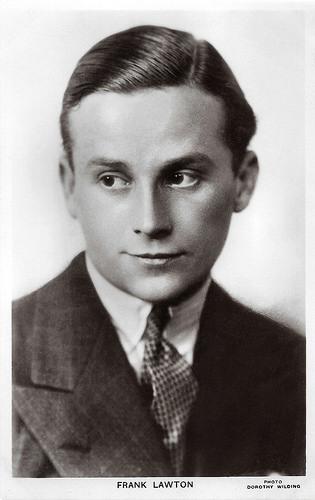
British postcard in the Picturegoer Series, London, no. 494. Photo: Dorothy Wilding.
Frank Lawton was born Frank Lawton Mokeley in 1904 in St Giles, London. His parents were stage players Daisy May Collier and Frank Lawton.
His first major screen credit was the lead role opposite Madeleine Carroll in the drama Young Woodley (Thomas Bentley, 1930) based on the controversial play by John van Druten. A school prefect becomes attracted to the headmaster's wife. The film, like the play, was noted for its subversive attitude to authority. The pompous and cold headmaster (Sam Livesey) is portrayed as the villain of the work. The film was not a major success when it was released despite its large budget and well-known subject matter.
That same year, he appeared in the Mystery Birds of Prey/The Perfect Alibi (Basil Dean, 1930) with Robert Loraine and Warwick Ward.
Alfred Hitchcock directed him in The Skin Game (Alfred Hitchcock, 1931), based on a play by John Galsworthy revolving around two rival families, the Hillcrists and the Hornblowers, and the disastrous results of the feud between them.
Another well-received film was the drama Michael and Mary (Victor Saville, 1931), in which he played the illegitimate son of Edna Best and Herbert Marshall. It was based on a play of the same name by A.A. Milne. Lawton played the lead in the romantic drama After Office Hours (Thomas Bentley, 1932), based on the 1931 play London Wall by John Van Druten with several of the cast reprising their roles from the original stage production.
Lawton moved to Hollywood to appear in the epic Pre-Code drama Cavalcade (Frank Lloyd, 1933), based on a play by Noël Coward, and starring Diana Wynyard and Clive Brook. The story presents a view of English life during the first quarter of the 20th century from New Year's Eve 1899 through New Year's Day 1933. The film won three Academy Awards, including Best Picture and Best Director, was the second most popular movie in the US in 1933 and made over US $1 million in the UK.
He then appeared in another John Galsworthy adaptation, the Mystery One More River (James Whale, 1934), with Diana Wynyard, Colin Clive and Mrs. Patrick Campbell. Lawton’s most significant role in Hollywood was as the adult David Copperfield in MGM's Charles Dickens adaption David Copperfield (George Cukor, 1935) with Freddie Bartholomew as the young David.
Frank Lawton also appeared in the Science fiction film melodrama The Invisible Ray (Lambert Hillyer, 1936) with Boris Karloff and Béla Lugosi, and the horror film The Devil-Doll (Tod Browning, 1936) starring a cross-dressing Lionel Barrymore, but he never made the breakthrough in Hollywood.
He returned to the British film and theatre. He starred in the British drama The Mill on the Floss (Tim Whelan, 1936) opposite Victoria Hopper, Geraldine Fitzgerald and James Mason, and later appeared in the thriller The Four Just Men/The Secret Four (Walter Forde, 1939) based on a novel by Edgar Wallace about four British World War I veterans who unite to work in secret against enemies of the country.
During the war, he rose to the rank of major and was awarded the U.S. Legion of Merit for liaison work in France. In the cinema, he appeared in the propaganda film Went the Day Well? (Alberto Cavalcanti, 1942) adapted from a story by Graham Greene about how an English village is taken over by Nazi paratroopers.
After the war, he had a supporting part in the successful The Winslow Boy (Anthony Asquith, 1948) with Robert Donat, Sir Cedric Hardwicke and Margaret Leighton. His later films include Gideon's Day (John Ford, 1958) with Jack Hawkins, the Titanic drama A Night to Remember (Roy Ward Baker, 1958) starring Kenneth More, and Michael Powell’s The Queen's Guards (1961) with Daniel and Raymond Massey. He was married to actress Virginia Earl and later to actress Evelyn Laye until his death. They acted together several times, including in the TV series My Husband and I. In 1969, Frank Lawton died in Marylebone, London. He was 64.
Sources: John "J-Cat" Griffith (Find A Grave), Wikipedia, and IMDb.

British postcard in the Picturegoer Series, London, no. 494. Photo: Dorothy Wilding.
Frank Lawton was born Frank Lawton Mokeley in 1904 in St Giles, London. His parents were stage players Daisy May Collier and Frank Lawton.
His first major screen credit was the lead role opposite Madeleine Carroll in the drama Young Woodley (Thomas Bentley, 1930) based on the controversial play by John van Druten. A school prefect becomes attracted to the headmaster's wife. The film, like the play, was noted for its subversive attitude to authority. The pompous and cold headmaster (Sam Livesey) is portrayed as the villain of the work. The film was not a major success when it was released despite its large budget and well-known subject matter.
That same year, he appeared in the Mystery Birds of Prey/The Perfect Alibi (Basil Dean, 1930) with Robert Loraine and Warwick Ward.
Alfred Hitchcock directed him in The Skin Game (Alfred Hitchcock, 1931), based on a play by John Galsworthy revolving around two rival families, the Hillcrists and the Hornblowers, and the disastrous results of the feud between them.
Another well-received film was the drama Michael and Mary (Victor Saville, 1931), in which he played the illegitimate son of Edna Best and Herbert Marshall. It was based on a play of the same name by A.A. Milne. Lawton played the lead in the romantic drama After Office Hours (Thomas Bentley, 1932), based on the 1931 play London Wall by John Van Druten with several of the cast reprising their roles from the original stage production.
Lawton moved to Hollywood to appear in the epic Pre-Code drama Cavalcade (Frank Lloyd, 1933), based on a play by Noël Coward, and starring Diana Wynyard and Clive Brook. The story presents a view of English life during the first quarter of the 20th century from New Year's Eve 1899 through New Year's Day 1933. The film won three Academy Awards, including Best Picture and Best Director, was the second most popular movie in the US in 1933 and made over US $1 million in the UK.
He then appeared in another John Galsworthy adaptation, the Mystery One More River (James Whale, 1934), with Diana Wynyard, Colin Clive and Mrs. Patrick Campbell. Lawton’s most significant role in Hollywood was as the adult David Copperfield in MGM's Charles Dickens adaption David Copperfield (George Cukor, 1935) with Freddie Bartholomew as the young David.
Frank Lawton also appeared in the Science fiction film melodrama The Invisible Ray (Lambert Hillyer, 1936) with Boris Karloff and Béla Lugosi, and the horror film The Devil-Doll (Tod Browning, 1936) starring a cross-dressing Lionel Barrymore, but he never made the breakthrough in Hollywood.
He returned to the British film and theatre. He starred in the British drama The Mill on the Floss (Tim Whelan, 1936) opposite Victoria Hopper, Geraldine Fitzgerald and James Mason, and later appeared in the thriller The Four Just Men/The Secret Four (Walter Forde, 1939) based on a novel by Edgar Wallace about four British World War I veterans who unite to work in secret against enemies of the country.
During the war, he rose to the rank of major and was awarded the U.S. Legion of Merit for liaison work in France. In the cinema, he appeared in the propaganda film Went the Day Well? (Alberto Cavalcanti, 1942) adapted from a story by Graham Greene about how an English village is taken over by Nazi paratroopers.
After the war, he had a supporting part in the successful The Winslow Boy (Anthony Asquith, 1948) with Robert Donat, Sir Cedric Hardwicke and Margaret Leighton. His later films include Gideon's Day (John Ford, 1958) with Jack Hawkins, the Titanic drama A Night to Remember (Roy Ward Baker, 1958) starring Kenneth More, and Michael Powell’s The Queen's Guards (1961) with Daniel and Raymond Massey. He was married to actress Virginia Earl and later to actress Evelyn Laye until his death. They acted together several times, including in the TV series My Husband and I. In 1969, Frank Lawton died in Marylebone, London. He was 64.
Sources: John "J-Cat" Griffith (Find A Grave), Wikipedia, and IMDb.
Published on October 23, 2018 22:00
October 22, 2018
Käthe Gold
Austrian actress Käthe Gold (1907–1997) was a successful theatre actress who worked in Austria, Germany and Switzerland. Her stage career prevented her from appearing in many films, although she did a few memorable performances.
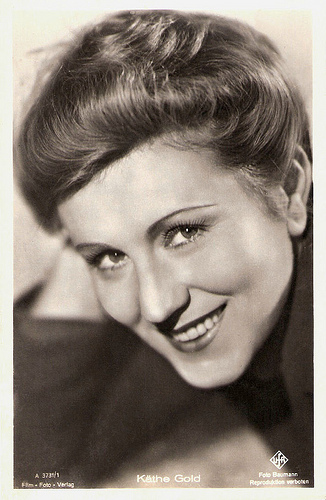
German postcard by Film-Foto-Verlag, no. A 3731/1, 1941-1944. Photo: Baumann/UFA.
Shrew
Katharina Stephanie Gold was born in Vienna, Austria-Hungary (now Austria) in 1907 and was the daughter of a Viennese locksmith.
She attended acting lessons at the Akademie für Musik und darstellende Kunst Wien (Academy of Music and Performing Arts Vienna).
In 1926 she made her stage debut as Bianca in Der Widerspenstigen Zähmung (The Taming of the Shrew) and from 1927 on she worked in Bern, Mönchengladbach, Breslau (today Wrocław), Munich and between 1932 and 1935 in Vienna at the Theater in der Josefstadt.
In 1935 she went to Berlin, where she remained until 1944. It was during those years that she had her greatest stage successes under the direction of Gustav Gründgens at the Preußischen Staatstheater (Prussian State Theatre).
She shone in such roles as Gretchen in Johann Wolfgang von Goethe's Faust, Ophelia in William Shakespeare's Hamlet, and Nora in Henrik Ibsen's A Doll's House.
Gold's stage career prevented her from appearing in many films. She made her film debut for the UFA as Alkmene in Amphitryon/Amphitryon - Happiness from the Clouds ( Reinhold Schünzel , 1935), a musical comedy about the ancient Greeks starring Willy Fritsch .
In Andere Welt/Other World (Marc Allégret, Alfred Stöger, 1937) she co-starred with Karl Ludwig Diehl. She played Gotthold Ephraim Lessing’s heroin Minna von Barnhelm in the comedy Das Fräulein von Barnhelm/Minna von Barnhelm (Hans Schweikart, 1940) with Ewald Balser and Theo Lingen .

German postcard by Film-Foto-Verlag, no. A 3631/1, 1941-1944. Photo: Binz / UFA.

German postcard, no. 222. Photo: Starfoto / Herzog Filmverleih.
Karl May
In 1944 Käthe Gold went to Zurich, Switzerland, and in 1947 she returned to Vienna. There she played at the Burgtheater and the Akademietheater and again enjoyed great successes. In 1985 she retired from the stage.
In the cinema, she appeared opposite René Deltgen in Augen der Liebe/Eyes of Love (Alfred Braun, 1951), and opposite Paul Hubschmid in Palace Hotel (Emil Berna, Leonard Steckel, 1952).
Also notable were Rose Bernd (Wolfgang Staudte, 1957) featuring Maria Schell , and the biopic Karl May (Hans-Jürgen Syberberg, 1976) featuring director Helmut Kaütner as the author of the Winnetou novels.
Her last film role was as Martha, the wife of author Robert Musil, in the Austrian production Die Reise ins tausendjährige Reich (Jürgen Kaizik, 1980). On TV she played again Ibsen’s Nora in Nora (Hanns Farenburg, 1955), Linda opposite Heinz Rühmann in Der Tod des Handlungsreisenden (1968), a German language version of Arthur Miller's Death of a Salesman, and opposite Cornelia Froboess in the comedy Der Wald/The Forrest (Wolfgang Glück, 1971).
She also had guest appearances in the popular TV krimis Der Kommissar/The Commissionar (1973-1974) and Derrick (1988).
In 1997, Käthe Gold died in her native Vienna, aged 90.

German postcard by Ross Verlag, no. A 3372/1, 1941-1944. Photo: K.L. Haenchen.
Scenes from the Burgtheater production Anatol by Arthur Schnitzler with Robert Lindner as Anatol.
Sources: Aeiou (German), Wikipedia (German and English), and .

German postcard by Film-Foto-Verlag, no. A 3731/1, 1941-1944. Photo: Baumann/UFA.
Shrew
Katharina Stephanie Gold was born in Vienna, Austria-Hungary (now Austria) in 1907 and was the daughter of a Viennese locksmith.
She attended acting lessons at the Akademie für Musik und darstellende Kunst Wien (Academy of Music and Performing Arts Vienna).
In 1926 she made her stage debut as Bianca in Der Widerspenstigen Zähmung (The Taming of the Shrew) and from 1927 on she worked in Bern, Mönchengladbach, Breslau (today Wrocław), Munich and between 1932 and 1935 in Vienna at the Theater in der Josefstadt.
In 1935 she went to Berlin, where she remained until 1944. It was during those years that she had her greatest stage successes under the direction of Gustav Gründgens at the Preußischen Staatstheater (Prussian State Theatre).
She shone in such roles as Gretchen in Johann Wolfgang von Goethe's Faust, Ophelia in William Shakespeare's Hamlet, and Nora in Henrik Ibsen's A Doll's House.
Gold's stage career prevented her from appearing in many films. She made her film debut for the UFA as Alkmene in Amphitryon/Amphitryon - Happiness from the Clouds ( Reinhold Schünzel , 1935), a musical comedy about the ancient Greeks starring Willy Fritsch .
In Andere Welt/Other World (Marc Allégret, Alfred Stöger, 1937) she co-starred with Karl Ludwig Diehl. She played Gotthold Ephraim Lessing’s heroin Minna von Barnhelm in the comedy Das Fräulein von Barnhelm/Minna von Barnhelm (Hans Schweikart, 1940) with Ewald Balser and Theo Lingen .

German postcard by Film-Foto-Verlag, no. A 3631/1, 1941-1944. Photo: Binz / UFA.

German postcard, no. 222. Photo: Starfoto / Herzog Filmverleih.
Karl May
In 1944 Käthe Gold went to Zurich, Switzerland, and in 1947 she returned to Vienna. There she played at the Burgtheater and the Akademietheater and again enjoyed great successes. In 1985 she retired from the stage.
In the cinema, she appeared opposite René Deltgen in Augen der Liebe/Eyes of Love (Alfred Braun, 1951), and opposite Paul Hubschmid in Palace Hotel (Emil Berna, Leonard Steckel, 1952).
Also notable were Rose Bernd (Wolfgang Staudte, 1957) featuring Maria Schell , and the biopic Karl May (Hans-Jürgen Syberberg, 1976) featuring director Helmut Kaütner as the author of the Winnetou novels.
Her last film role was as Martha, the wife of author Robert Musil, in the Austrian production Die Reise ins tausendjährige Reich (Jürgen Kaizik, 1980). On TV she played again Ibsen’s Nora in Nora (Hanns Farenburg, 1955), Linda opposite Heinz Rühmann in Der Tod des Handlungsreisenden (1968), a German language version of Arthur Miller's Death of a Salesman, and opposite Cornelia Froboess in the comedy Der Wald/The Forrest (Wolfgang Glück, 1971).
She also had guest appearances in the popular TV krimis Der Kommissar/The Commissionar (1973-1974) and Derrick (1988).
In 1997, Käthe Gold died in her native Vienna, aged 90.

German postcard by Ross Verlag, no. A 3372/1, 1941-1944. Photo: K.L. Haenchen.
Scenes from the Burgtheater production Anatol by Arthur Schnitzler with Robert Lindner as Anatol.
Sources: Aeiou (German), Wikipedia (German and English), and .
Published on October 22, 2018 22:00
October 21, 2018
Frida Gombaszögi
Frida Gombaszögi (1890–1961) was the first Hungarian actress who represented the modern acting style in plays by Molnar, Chekhov and Gorky. During her long and impressive career, she also appeared in silent films and one sound film.

Hungarian postcard. Publisher: Globus, Budapest. Photo: Angelo Photos. Collection: Didier Hanson.
Enchanted Prince
Frida Gombaszögi was born Friderika Vilma Grün in Budapest, Hungary in 1890. Her sisters Ella, Irèn en Margit would all become actresses. Ella became a comic actress, but Frida specialised in drama.
In 1909 Frida started her stage career after the completion of the Színiakadémián (Hungarian Theatre Academy). She was signed by László Beöthy, director of the Magyar Színház (Hungarian Theatre).
With her sophisticated appearance, her polished movements and cultured speech culture, and her intelligent, expressive play, she created modern dramatic heroines in plays by Ferenc Molnar, Henrik Ibsen, Anton Chekhov and Maxim Gorky. Between 1916 and 1933 she was a member of the Vígszínház (Comedy Theatre).
During that period, she also played in silent Hungarian films. She made her film debut opposite Victor Varconi in Farkas/The Wolf (1917), based on a play by Ferenc Molnar in which she had appeared on stage. The film was directed by Mihály Kertész, who would later become known as Hollywood director Michael Curtiz.
In 1918, she starred in A Szerelem bolondjai/The Fools of Love (Carl Wilhelm, 1918) and another Molnar adaptation, A testör/The bodyguard (Alexander Antalffy, 1918).
The following year, she co-starred with her sister Ella Gombaszögi in Átok vára/Bane's castle (Károly Lajthay, 1919) and Sundal/Sund (Károly Lajthay, 1919). The two sisters also appeared in Vorrei morir/I Want to Die (Károly Lajthay, 1919). The film starred Károly Mihályfi, and the Gombaszögi sisters only played supporting parts in it.
Her final silent film was Tláni, az elvarázsolt hercegasszony/False, he is an enchanted prince (Károly Lajthay, 1920). In this film she played the female lead opposite Pál Lukács, who would later become a renowned, Oscar winning Hollywood star under the name Paul Lukas .

Hungarian postcard by Reinitz Jòzsef, Budapest / Terjeszti Gonda Oszkàr, Budapest. Photo: Angelo, 1918.
Killed by a Bomb
In 1919, Frida Gombaszögi was shot by a young man, probably a fan, who then committed suicide. The actress was severely injured in her face, and for a long time it was unsure if she could ever return to the stage. Her first appearance after healing was received with a loud celebration. The cosmetic-dermatologist Ernő László had almost eliminated all traces of the injury. Frida's sister, Irén later married László and in 1939 the couple moved to the US.
Frida Gombaszögi was married three times. Her first husband was stage and film actor Rajnai Gábor, whom she married in 1909. They divorced in 1918 but they would stay friends during her whole life.
In 1922, she married journalist and publisher Miklós Andornak, who was killed in 1933 by a bomb. Frida Gombaszögi retired from the stage and became the owner and CEO of her husband's Atheneum Publishing company and Az Est (The East) newspaper.
Her third husband was writer, poet, journalist, producer, playwright and politician Jenő Heltai.
After the war she worked again for the Vígszínház and also for the prestigious Nemzeti Színház (National Theatre). She also worked as a drama teacher at the Színművészeti Főiskola between 1953 and 1956.
In 1956 she also appeared in a sound film, Az élet hídja/The Bridge of Life (Márton Keleti, 1956).
Her career was again interrupted by the political manoeuvres of the communist regime and she had to leave Budapest and work in a provincial theatre. At the end of her life she also worked for television.
Why she did not appear in more films is not clear. Her sister Ella Gombaszögi was a well known film actress during the 1930s.
Frida Gombaszögi died in 1961 in Budapest. She was 70.
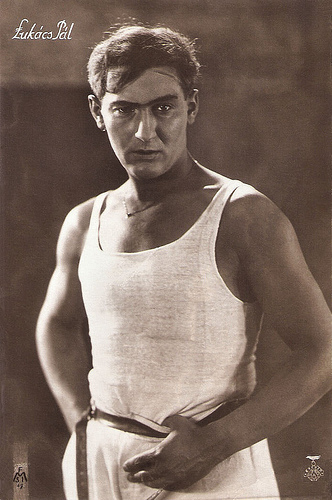
Paul Lukas . Hungarian postcard by FMSI, no.17. Photo: Korvin / Joe May Film.
Sources: Takács István (szineszkonyvtar.hu - Hungarian), György Székely (Magyar színházművészeti lexikon - Hungarian), Wikipedia (Hungarian) and .

Hungarian postcard. Publisher: Globus, Budapest. Photo: Angelo Photos. Collection: Didier Hanson.
Enchanted Prince
Frida Gombaszögi was born Friderika Vilma Grün in Budapest, Hungary in 1890. Her sisters Ella, Irèn en Margit would all become actresses. Ella became a comic actress, but Frida specialised in drama.
In 1909 Frida started her stage career after the completion of the Színiakadémián (Hungarian Theatre Academy). She was signed by László Beöthy, director of the Magyar Színház (Hungarian Theatre).
With her sophisticated appearance, her polished movements and cultured speech culture, and her intelligent, expressive play, she created modern dramatic heroines in plays by Ferenc Molnar, Henrik Ibsen, Anton Chekhov and Maxim Gorky. Between 1916 and 1933 she was a member of the Vígszínház (Comedy Theatre).
During that period, she also played in silent Hungarian films. She made her film debut opposite Victor Varconi in Farkas/The Wolf (1917), based on a play by Ferenc Molnar in which she had appeared on stage. The film was directed by Mihály Kertész, who would later become known as Hollywood director Michael Curtiz.
In 1918, she starred in A Szerelem bolondjai/The Fools of Love (Carl Wilhelm, 1918) and another Molnar adaptation, A testör/The bodyguard (Alexander Antalffy, 1918).
The following year, she co-starred with her sister Ella Gombaszögi in Átok vára/Bane's castle (Károly Lajthay, 1919) and Sundal/Sund (Károly Lajthay, 1919). The two sisters also appeared in Vorrei morir/I Want to Die (Károly Lajthay, 1919). The film starred Károly Mihályfi, and the Gombaszögi sisters only played supporting parts in it.
Her final silent film was Tláni, az elvarázsolt hercegasszony/False, he is an enchanted prince (Károly Lajthay, 1920). In this film she played the female lead opposite Pál Lukács, who would later become a renowned, Oscar winning Hollywood star under the name Paul Lukas .

Hungarian postcard by Reinitz Jòzsef, Budapest / Terjeszti Gonda Oszkàr, Budapest. Photo: Angelo, 1918.
Killed by a Bomb
In 1919, Frida Gombaszögi was shot by a young man, probably a fan, who then committed suicide. The actress was severely injured in her face, and for a long time it was unsure if she could ever return to the stage. Her first appearance after healing was received with a loud celebration. The cosmetic-dermatologist Ernő László had almost eliminated all traces of the injury. Frida's sister, Irén later married László and in 1939 the couple moved to the US.
Frida Gombaszögi was married three times. Her first husband was stage and film actor Rajnai Gábor, whom she married in 1909. They divorced in 1918 but they would stay friends during her whole life.
In 1922, she married journalist and publisher Miklós Andornak, who was killed in 1933 by a bomb. Frida Gombaszögi retired from the stage and became the owner and CEO of her husband's Atheneum Publishing company and Az Est (The East) newspaper.
Her third husband was writer, poet, journalist, producer, playwright and politician Jenő Heltai.
After the war she worked again for the Vígszínház and also for the prestigious Nemzeti Színház (National Theatre). She also worked as a drama teacher at the Színművészeti Főiskola between 1953 and 1956.
In 1956 she also appeared in a sound film, Az élet hídja/The Bridge of Life (Márton Keleti, 1956).
Her career was again interrupted by the political manoeuvres of the communist regime and she had to leave Budapest and work in a provincial theatre. At the end of her life she also worked for television.
Why she did not appear in more films is not clear. Her sister Ella Gombaszögi was a well known film actress during the 1930s.
Frida Gombaszögi died in 1961 in Budapest. She was 70.

Paul Lukas . Hungarian postcard by FMSI, no.17. Photo: Korvin / Joe May Film.
Sources: Takács István (szineszkonyvtar.hu - Hungarian), György Székely (Magyar színházművészeti lexikon - Hungarian), Wikipedia (Hungarian) and .
Published on October 21, 2018 22:00
October 20, 2018
Gilberte Savary
French child actress Gilberte Savary (1921-1992) appeared in six films such as Le rêve (1931), La ronde des heures (1931) and Les Miserables (1934).

French postcard in the Nos Artistes series. Caption: Jeune Vedette des Films Parlants (Young star of the sound cinema).

French postcard by Cinémagazine-Édition, Paris, no. 2064. Photo: Studio Arnal, Paris.

French postcard by A.N., Paris, no. 718.
The daughter of a clown
Gilberte Thérèse Louise Savary was born in 1921 in Paris.
She made her film debut as a little girl in the silent film La faute de Monique/Monique’s fault (Maurice Gleize, 1928), with Sandra Milovanoff and Rudolf Klein Rogge .
The following year, she had a small part in the Alexandre Dumas adaptation Le collier de la reine/The Queen's Necklace (Tony Lekain, Gaston Ravel, 1929) starring Marcelle Chantal and Diana Karenne .
She had one of the leading roles in the circus drama La ronde des heures/Round of Hours (Alexandre Ryder, 1931) as the daughter of clown André Baugé . The success of the film made her a child star and in 1931, she appeared in a total of four films.
One was a bit role in Tout ça ne vaut pas l'amour/All that is not worth the love (Jacques Tourneur, 1931) with Marcel Lévesque and the young Jean Gabin both falling in love with Josseline Gael .

French postcard by Photo Combier, Macon. Photo: Arnal, Paris. Caption: Gilberte Savary, star of Boite à Joujoux/The Toy-Box. The most amazing artist of the era of sound cinema, radio, Music Hall.

French postcard by Photo Combier, Macon. Caption: "Our artists. Gilberte Savary, realistic star of Boite à Joujoux/The Toy-Box."
A mystical atmosphere
In 1923, director Jacques de Baroncelli had made the fairy tale-like Le rêve/The Dream (1923), a silent film version of the sixteenth volume in Emile Zola's Rougon-Macquart saga.
In 1931 he made a sound version, Le rêve/The Dream (1931), now with Gilberte Savary as a lost child who is adopted by a humble family. When she has grown up, the girl (now played by Simone Genevois) falls in love with the bishop's son (Jaque Catelain), and the old man who plans a beau marriage is not prepared to accept it.
D.B. DuMonteil at IMDb : “The painstaking pictures, the use of the settings in the cathedral and of the canticles create a mystical atmosphere. Unfortunately, the two lovers verge on ludicrous. Simone Genevois's and Jacques Catelain 's playing make the movie some kind of middle-brow show. A curiosity.”
Finally in her last film appearance, Savary played the young Eponine Thénardier in the epic Les Miserables (Raymond Bernard, 1934) starring Harry Baur as ex-convict Jean Valjean and Charles Vanel as the obsessive police inspector Javert.
Now an adolescent, Gilberte retired from the screen. Marlene Pilate suggests at La Collectionneuse that Savary possibly also worked on stage and for the radio. And indeed Gilberte Savary appeared as variety artist singing chansons in theatres, even in the Netherlands in 1938.
Little is known about her later life. Gilberte Savary died in 1992 in Clayes-sous-Bois near Paris, when she was 70.

French postcard by Photo Combier, Macon. Caption: "En souvenir des films Gilberte Savary." With pictures of Tout ça ne vaut pas l'amour a.k.a. Un vieux garçon (Jacques Tourneur, 1931), Le collier de la reine/The Queen's Necklace (Tony Lekain, Gaston Ravel, 1929), La ronde des heures/Round of Hours (Alexandre Ryder, 1931) and Le rêve/The Dream (Jacques de Baroncelli, 1931).
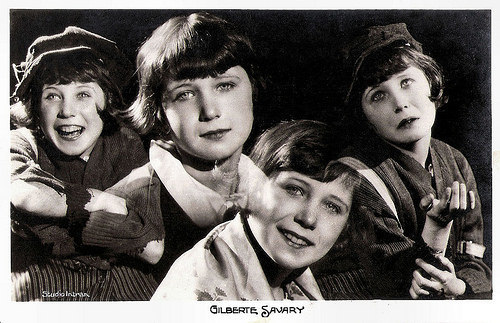
French postcard. Photo: Studfio Intran.
Sources: Marlene Pilaete (La Collectionneuse – French), D.B. DuMonteil (IMDb), Delpher (Dutch), Wikipedia (French) and .

French postcard in the Nos Artistes series. Caption: Jeune Vedette des Films Parlants (Young star of the sound cinema).

French postcard by Cinémagazine-Édition, Paris, no. 2064. Photo: Studio Arnal, Paris.

French postcard by A.N., Paris, no. 718.
The daughter of a clown
Gilberte Thérèse Louise Savary was born in 1921 in Paris.
She made her film debut as a little girl in the silent film La faute de Monique/Monique’s fault (Maurice Gleize, 1928), with Sandra Milovanoff and Rudolf Klein Rogge .
The following year, she had a small part in the Alexandre Dumas adaptation Le collier de la reine/The Queen's Necklace (Tony Lekain, Gaston Ravel, 1929) starring Marcelle Chantal and Diana Karenne .
She had one of the leading roles in the circus drama La ronde des heures/Round of Hours (Alexandre Ryder, 1931) as the daughter of clown André Baugé . The success of the film made her a child star and in 1931, she appeared in a total of four films.
One was a bit role in Tout ça ne vaut pas l'amour/All that is not worth the love (Jacques Tourneur, 1931) with Marcel Lévesque and the young Jean Gabin both falling in love with Josseline Gael .

French postcard by Photo Combier, Macon. Photo: Arnal, Paris. Caption: Gilberte Savary, star of Boite à Joujoux/The Toy-Box. The most amazing artist of the era of sound cinema, radio, Music Hall.

French postcard by Photo Combier, Macon. Caption: "Our artists. Gilberte Savary, realistic star of Boite à Joujoux/The Toy-Box."
A mystical atmosphere
In 1923, director Jacques de Baroncelli had made the fairy tale-like Le rêve/The Dream (1923), a silent film version of the sixteenth volume in Emile Zola's Rougon-Macquart saga.
In 1931 he made a sound version, Le rêve/The Dream (1931), now with Gilberte Savary as a lost child who is adopted by a humble family. When she has grown up, the girl (now played by Simone Genevois) falls in love with the bishop's son (Jaque Catelain), and the old man who plans a beau marriage is not prepared to accept it.
D.B. DuMonteil at IMDb : “The painstaking pictures, the use of the settings in the cathedral and of the canticles create a mystical atmosphere. Unfortunately, the two lovers verge on ludicrous. Simone Genevois's and Jacques Catelain 's playing make the movie some kind of middle-brow show. A curiosity.”
Finally in her last film appearance, Savary played the young Eponine Thénardier in the epic Les Miserables (Raymond Bernard, 1934) starring Harry Baur as ex-convict Jean Valjean and Charles Vanel as the obsessive police inspector Javert.
Now an adolescent, Gilberte retired from the screen. Marlene Pilate suggests at La Collectionneuse that Savary possibly also worked on stage and for the radio. And indeed Gilberte Savary appeared as variety artist singing chansons in theatres, even in the Netherlands in 1938.
Little is known about her later life. Gilberte Savary died in 1992 in Clayes-sous-Bois near Paris, when she was 70.

French postcard by Photo Combier, Macon. Caption: "En souvenir des films Gilberte Savary." With pictures of Tout ça ne vaut pas l'amour a.k.a. Un vieux garçon (Jacques Tourneur, 1931), Le collier de la reine/The Queen's Necklace (Tony Lekain, Gaston Ravel, 1929), La ronde des heures/Round of Hours (Alexandre Ryder, 1931) and Le rêve/The Dream (Jacques de Baroncelli, 1931).

French postcard. Photo: Studfio Intran.
Sources: Marlene Pilaete (La Collectionneuse – French), D.B. DuMonteil (IMDb), Delpher (Dutch), Wikipedia (French) and .
Published on October 20, 2018 22:00
October 19, 2018
Photo by Nicola Perscheid
German photographer Nicola Perscheid (1864-1930) is primarily known for his artistic portrait photography. He developed the 'Perscheid lens', a soft focus lens for large format portrait photography. For several film star postcards of the 1910s and 1920s by Verlag Hermann Leiser, Photochemie, Rotophot and Ross Verlag, Perscheid took the photos.
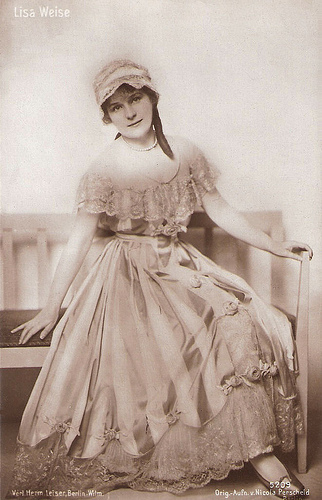
Lisa Weise . German postcard by Verlag Hermann Leiser, Berlin Wilm., no. 5209. Photo: Nicola Perscheid.
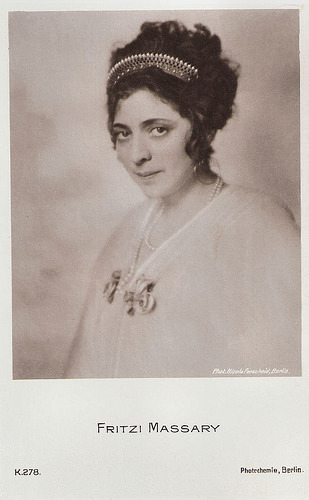
Fritzi Massary. German postcard by Photochemie, Berlin, no. K. 278. Photo: Nicola Perscheid, Berlin.
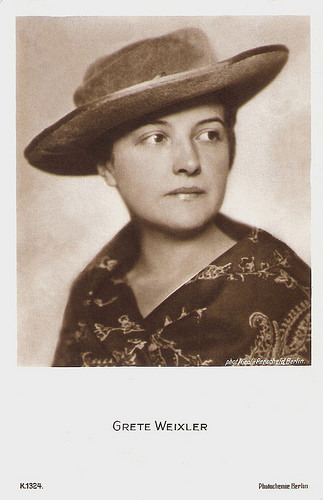
Grete Weixler . German postcard by Photochemie, Berlin, no. K 1324. Photo: Nicola Perscheid, Berlin.
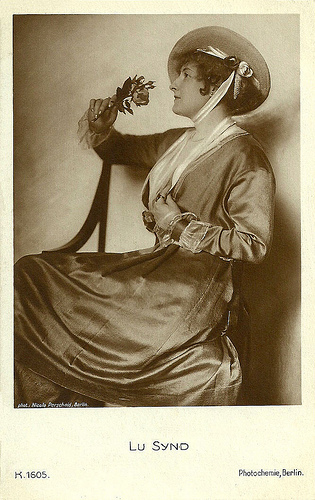
Lu Synd . German postcard by Photochemie, Berlin. no. K. 1605. Photo: Nicola Perscheid, Berlin.

Nils Chrisander . German postcard by Photochemie, Berlin., no. 1642. Photo: Nicola Perscheid, Berlin.
Court photographer
Nicola Perscheid was born as Nikolaus Perscheid in Moselweiß near Koblenz (now part of Koblenz), Germany, in 1864. There he also went to school.
At the age of 15, he began an apprenticeship as a photographer in the studio Reuss & Müller in Koblenz. Subsequently, Perscheid earned his living as an itinerant photographer. He worked in Saarbrücken, Trier, and Colmar, but also in Nice, Vienna, or Budapest.
In Klagenfurt in Austria he finally found a permanent position and on 1 March 1887, he became a member of the Photographic Society of Vienna (Wiener Photographische Gesellschaft). In 1889, he moved to Dresden, where he initially worked in the studio of Wilhelm Höffert, a well-known studio in Germany at that time.
In 1891, Perscheid opened his own studio in Görlitz. The next year, he was appointed court photographer at the court of Albert, King of Saxony. In 1894, he moved to Leipzig, where he mainly made conventional studio photography.
Perscheid had his first publication of a photo in a renowned photography magazine in 1897, and from then on his work started to show new artistic impulses. He brought what was then a newer, painterly side to photography. His photography focused on portraiture, and especially his portraits of women are often in soft focus.
From 1899 to 1902, he participated in numerous national and international exhibitions in connection with the art photography movement and the artistic criteria this movement proclaimed. Perscheid also had contacts with the artist Max Klinger, whom he also photographed.
As an established and well-known photographer, he moved in 1905 to Berlin, where he opened an elegant studio. Among the celebrities he portrayed are the physician Wilhelm Conrad Röntgen, politician Paul von Hindenburg, singer Fritzi Massari, author Gerhart Hauptmann and flying ace Manfred von Richthofen.
From 1903 on, he experimented with early techniques for colour photography, without much success. When his assistant Arthur Benda left him in 1907, Perscheid gave up these experiments altogether.
His portraits, however, won him several important awards. In 1909 he received the Grand Silver Medal, the highest award for professional photographers at the 38th convention of the German Photographers Association in Weimar.
Apparently his studio was not an economic success: he sold it in 1912. In October 1913, he held a course at the Swedish society of professional photographers, the Svenska Fotografernas Förbund, which must have been a success as it was praised even ten years later. In 1923, he followed a call by the Danish college for photography in Kopenhagen.
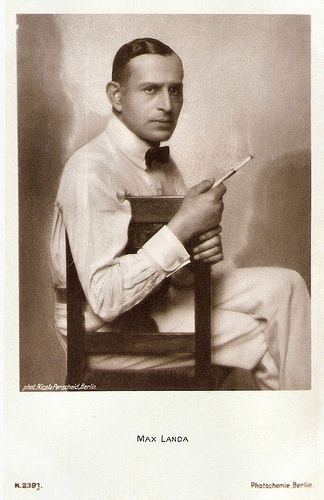
Max Landa . German postcard by Photochemie, Berlin, no. K 2391. Photo: Nicola Perscheid, Berlin.

Maria Widal . German postcard in the Filmsterne series by Rotophot, no. 112/1. Photo: Nicola Perscheid, Berlin.
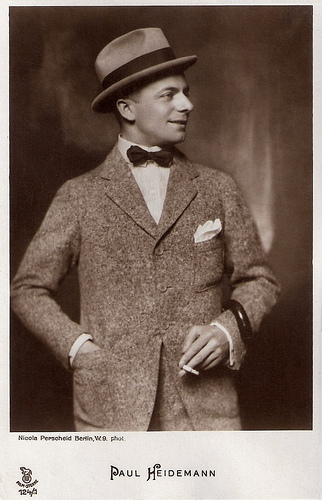
Paul Heidemann . German postcard by Rotophot in the Film Sterne series, no. 124/1. Photo: Nicola Perscheid, Berlin.
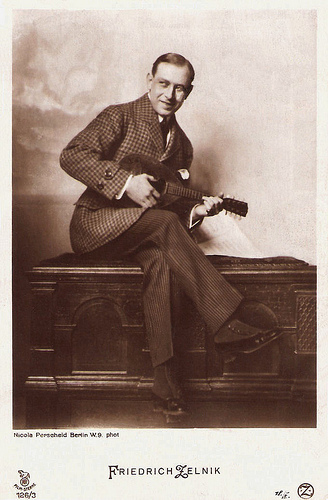
Friedrich Zelnik . German postcard by Rotophot in the Film Sterne series, no. 126/3. Photo: Nicola Perscheid, Berlin.
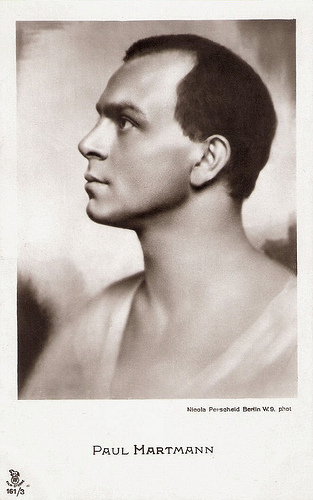
Paul Hartmann . German postcard in the Film-Sterne series by Rotophot, no. 161/3. Photo: Nicole Perscheid, Berlin.
The Perscheid lens
Sabine Schnakenberg notes about Nicola Perscheid: "With Rudolph Dührkoop (1848-1918) and Hugo Erfurth (1875-1948) Perscheid belonged to those professional photographers who followed their own design ideas and were able to implement them for a small, affluent clientele. Characteristic was their closer examination of the person to be portrayed, whereby Perscheid succeeded in fulfilling the demanded contemporary demands on 'individuality', 'characteristics' and 'truth' of the portrayed by the use of simple clothes and backgrounds, the abandonment of studio props and to fulfil the economical use of retouching while exploiting the technical potential."
Perscheid had several students who would later become renowned photographers themselves. Arthur Benda studied with him from 1899 to 1902, and joined him again in 1906 as his assistant for experimenting with colour photography. Benda left Perscheid in 1907. Together with Dora Kallmus, he went to Vienna and worked in her studio Atelier d'Ora, which he eventually took over. The studio continued to exist under the name d'Ora-Benda until 1965.
Kallmus herself also had studied from January to May 1907 at Perscheid's. Henry B. Goodwin, who later emigrated to Sweden and in 1913 organised Perscheid's course there, studied with Perscheid in 1903. In 1924 the Swedish photographer Curt Götlin studied at Perscheid's studio. Perscheid also influenced the Japanese photographer Toragorō Ariga, who studied in Berlin from 1908 to 1914 and also followed Perscheid's courses. He returned in 1915 to Japan.
The Perscheid lens was developed around 1920. It is a soft-focus lens with a wide depth of field, produced by Emil Busch AG in Rathenow Germany, after the specifications of Perscheid. The lens is designed especially for large format portrait photography. Ariga introduced the Perscheid lens in Japan, where it became very popular amongst Japanese portrait photographers of the 1920s.
Even after the sale of his studio, Perscheid continued to work as a photographer and even rented other studio rooms in 1917. In these years, he made dozens portraits of film stars of the burgeoning German silent cinema. They were used for postcards by such Berlin publishers as Verlag Hermann Leiser, Photochemie and Rotophot with was later transformed into Ross Verlag.
Besides artistic photography, Perscheid also always did 'profane' studio portraits, for instance for the Postkartenvertrieb Willi Sanke in Berlin that between 1910 and 1918 published a series of about 600 to 700 numbered aviation postcards, including a large number of portraits of flying aces, a number of which were done by Perscheid.
Towards the end of the 1920s, Perscheid had severe financial problems. In autumn 1929 he had to sub-rent his apartment to be able to pay his own rent. Shortly afterwards, he suffered a stroke, and was hospitalised in spring of 1930. While he was at the hospital, his belongings, including his cameras and photographic plates, but also all his furniture were auctioned off to pay his debts.
Two weeks after the auction, on 12 May 1930, Nicola Perscheid died at the Charité hospital in Berlin.

Henny Porten . German postcard in the Film Sterne Series by Rotophot, no. 167/2. Photo: Nicola Perscheid / Messter Film, Berlin.

Arnold Rieck. German postcard in the Film Sterne series by Rotophot, no. 185/4. Photo: Nicola Perscheid / Messter Film, Berlin.

Hella Moja . German postcard by Ross Verlag, Berlin, no. 313/1, 1919-1924. Photo: Nicola Perscheid.
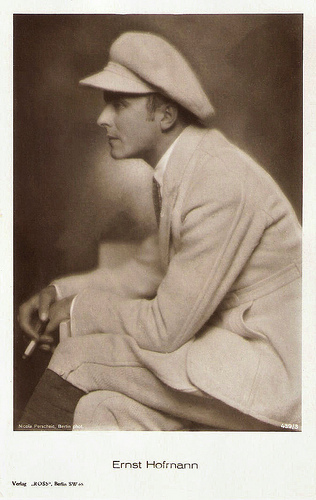
Ernst Hoffmann . German postcard by Ross Verlag, Berlin, no. 439/3, 1919-1924. Photo: Nicola Perscheid, Berlin.
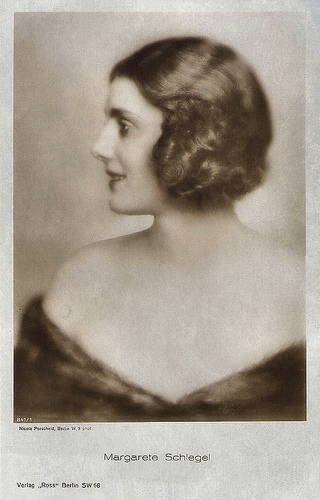
Margarete Schlegel. German postcard by Ross Verlag, no. 841/1, 1925-1926. Photo: Nicola Perscheid, Berlin.
Sources: Sabine Schnakenberg (Deutsche Biografie - German), Lomography and Wikipedia.

Lisa Weise . German postcard by Verlag Hermann Leiser, Berlin Wilm., no. 5209. Photo: Nicola Perscheid.

Fritzi Massary. German postcard by Photochemie, Berlin, no. K. 278. Photo: Nicola Perscheid, Berlin.

Grete Weixler . German postcard by Photochemie, Berlin, no. K 1324. Photo: Nicola Perscheid, Berlin.

Lu Synd . German postcard by Photochemie, Berlin. no. K. 1605. Photo: Nicola Perscheid, Berlin.

Nils Chrisander . German postcard by Photochemie, Berlin., no. 1642. Photo: Nicola Perscheid, Berlin.
Court photographer
Nicola Perscheid was born as Nikolaus Perscheid in Moselweiß near Koblenz (now part of Koblenz), Germany, in 1864. There he also went to school.
At the age of 15, he began an apprenticeship as a photographer in the studio Reuss & Müller in Koblenz. Subsequently, Perscheid earned his living as an itinerant photographer. He worked in Saarbrücken, Trier, and Colmar, but also in Nice, Vienna, or Budapest.
In Klagenfurt in Austria he finally found a permanent position and on 1 March 1887, he became a member of the Photographic Society of Vienna (Wiener Photographische Gesellschaft). In 1889, he moved to Dresden, where he initially worked in the studio of Wilhelm Höffert, a well-known studio in Germany at that time.
In 1891, Perscheid opened his own studio in Görlitz. The next year, he was appointed court photographer at the court of Albert, King of Saxony. In 1894, he moved to Leipzig, where he mainly made conventional studio photography.
Perscheid had his first publication of a photo in a renowned photography magazine in 1897, and from then on his work started to show new artistic impulses. He brought what was then a newer, painterly side to photography. His photography focused on portraiture, and especially his portraits of women are often in soft focus.
From 1899 to 1902, he participated in numerous national and international exhibitions in connection with the art photography movement and the artistic criteria this movement proclaimed. Perscheid also had contacts with the artist Max Klinger, whom he also photographed.
As an established and well-known photographer, he moved in 1905 to Berlin, where he opened an elegant studio. Among the celebrities he portrayed are the physician Wilhelm Conrad Röntgen, politician Paul von Hindenburg, singer Fritzi Massari, author Gerhart Hauptmann and flying ace Manfred von Richthofen.
From 1903 on, he experimented with early techniques for colour photography, without much success. When his assistant Arthur Benda left him in 1907, Perscheid gave up these experiments altogether.
His portraits, however, won him several important awards. In 1909 he received the Grand Silver Medal, the highest award for professional photographers at the 38th convention of the German Photographers Association in Weimar.
Apparently his studio was not an economic success: he sold it in 1912. In October 1913, he held a course at the Swedish society of professional photographers, the Svenska Fotografernas Förbund, which must have been a success as it was praised even ten years later. In 1923, he followed a call by the Danish college for photography in Kopenhagen.

Max Landa . German postcard by Photochemie, Berlin, no. K 2391. Photo: Nicola Perscheid, Berlin.

Maria Widal . German postcard in the Filmsterne series by Rotophot, no. 112/1. Photo: Nicola Perscheid, Berlin.

Paul Heidemann . German postcard by Rotophot in the Film Sterne series, no. 124/1. Photo: Nicola Perscheid, Berlin.

Friedrich Zelnik . German postcard by Rotophot in the Film Sterne series, no. 126/3. Photo: Nicola Perscheid, Berlin.

Paul Hartmann . German postcard in the Film-Sterne series by Rotophot, no. 161/3. Photo: Nicole Perscheid, Berlin.
The Perscheid lens
Sabine Schnakenberg notes about Nicola Perscheid: "With Rudolph Dührkoop (1848-1918) and Hugo Erfurth (1875-1948) Perscheid belonged to those professional photographers who followed their own design ideas and were able to implement them for a small, affluent clientele. Characteristic was their closer examination of the person to be portrayed, whereby Perscheid succeeded in fulfilling the demanded contemporary demands on 'individuality', 'characteristics' and 'truth' of the portrayed by the use of simple clothes and backgrounds, the abandonment of studio props and to fulfil the economical use of retouching while exploiting the technical potential."
Perscheid had several students who would later become renowned photographers themselves. Arthur Benda studied with him from 1899 to 1902, and joined him again in 1906 as his assistant for experimenting with colour photography. Benda left Perscheid in 1907. Together with Dora Kallmus, he went to Vienna and worked in her studio Atelier d'Ora, which he eventually took over. The studio continued to exist under the name d'Ora-Benda until 1965.
Kallmus herself also had studied from January to May 1907 at Perscheid's. Henry B. Goodwin, who later emigrated to Sweden and in 1913 organised Perscheid's course there, studied with Perscheid in 1903. In 1924 the Swedish photographer Curt Götlin studied at Perscheid's studio. Perscheid also influenced the Japanese photographer Toragorō Ariga, who studied in Berlin from 1908 to 1914 and also followed Perscheid's courses. He returned in 1915 to Japan.
The Perscheid lens was developed around 1920. It is a soft-focus lens with a wide depth of field, produced by Emil Busch AG in Rathenow Germany, after the specifications of Perscheid. The lens is designed especially for large format portrait photography. Ariga introduced the Perscheid lens in Japan, where it became very popular amongst Japanese portrait photographers of the 1920s.
Even after the sale of his studio, Perscheid continued to work as a photographer and even rented other studio rooms in 1917. In these years, he made dozens portraits of film stars of the burgeoning German silent cinema. They were used for postcards by such Berlin publishers as Verlag Hermann Leiser, Photochemie and Rotophot with was later transformed into Ross Verlag.
Besides artistic photography, Perscheid also always did 'profane' studio portraits, for instance for the Postkartenvertrieb Willi Sanke in Berlin that between 1910 and 1918 published a series of about 600 to 700 numbered aviation postcards, including a large number of portraits of flying aces, a number of which were done by Perscheid.
Towards the end of the 1920s, Perscheid had severe financial problems. In autumn 1929 he had to sub-rent his apartment to be able to pay his own rent. Shortly afterwards, he suffered a stroke, and was hospitalised in spring of 1930. While he was at the hospital, his belongings, including his cameras and photographic plates, but also all his furniture were auctioned off to pay his debts.
Two weeks after the auction, on 12 May 1930, Nicola Perscheid died at the Charité hospital in Berlin.

Henny Porten . German postcard in the Film Sterne Series by Rotophot, no. 167/2. Photo: Nicola Perscheid / Messter Film, Berlin.

Arnold Rieck. German postcard in the Film Sterne series by Rotophot, no. 185/4. Photo: Nicola Perscheid / Messter Film, Berlin.

Hella Moja . German postcard by Ross Verlag, Berlin, no. 313/1, 1919-1924. Photo: Nicola Perscheid.

Ernst Hoffmann . German postcard by Ross Verlag, Berlin, no. 439/3, 1919-1924. Photo: Nicola Perscheid, Berlin.

Margarete Schlegel. German postcard by Ross Verlag, no. 841/1, 1925-1926. Photo: Nicola Perscheid, Berlin.
Sources: Sabine Schnakenberg (Deutsche Biografie - German), Lomography and Wikipedia.
Published on October 19, 2018 22:00
October 18, 2018
Horst Caspar
German actor Horst Caspar (1913-1952) was prominent in German theatre, radio and a few films in the 1930s and 1940s. His postwar career was cut short by his sudden death at 39.
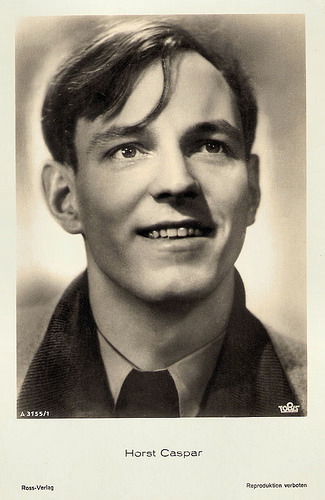
German postcard by Ross Verlag, no. A 3155/1, 1941-1944. Photo: Tobis.

German postcard by Ross Verlag, no. A 3208/1, 1941-1944. Photo: Tobis / Dähn.
Mischling of the second degree
Horst Joachim Arthur Caspar was born in 1913 in Radegast, Germany. He was the son of Max Caspar, an army officer. He had one Jewish grandparent. Caspar’s mother named Emmy (birth name Hentschel) was twelve years younger than his father. She was the daughter of a hotelier. She gave birth to three sons: Theodor, Hans and Horst. Emmy passed away of a pneumonia at the age of 25 years, when Horst was only 18 months old.
He was raised by an aunt in Berlin, Nora Hartwich, and attended the Treitschke-Reform-Realgymnasium in Berlin-Wilmersdorf. In 1932 he took his abitur (school leaving exam), but did not go to university, since he had already decided to be an actor.
The Roman herald in William Shakespeare’s Coriolan was Caspar's first stage role, performed in 1933. He took acting lessons at the school of Ilka Grüning and Lucie Höflich, along with future stars of German cinema such as Lilli Palmer , Inge Meysel and Brigitte Horney .
In 1933, the handsome young man was taken up by the director Saladin Schmitt and became a leading man at the Bochumer Stadttheater. In Bochum, he performed in plays by William Shakespeare and Friedrich Schiller, often in youthful heroic roles.
Under the Nazi regime's anti-Jewish Nuremberg Laws, Horst Caspar was classed as a Mischling (mixed race) of the second degree. Despite his part-Jewish ancestry, he continued to work as an actor. This was partly because he enjoyed the protection of Saladin Schmitt, who as a homosexual was no friend of the Nazi regime.
But he also enjoyed the patronage of Propaganda Minister Joseph Goebbels. Goebbels personally vetted cases of part-Jewish performers and allowed a number of popular part-Jewish actors to continue working.
When he gave his final performance in Bochum in Richard II in 1939, he received 108 curtain calls. He moved to Munich where he was working at the Munich Kammerspiele (1938-1940).
His first leading film role was as the young Schiller in Friedrich Schiller – Der Triumph eines Genies/Friedrich Schiller – The Triumph of a Genius (Herbert Maisch, 1940). The film focuses on the early career of the German poet Friedrich Schiller.

German postcard by Ross Verlag, no. A 3397/1, 1941-1944. Photo: Tobis / Dähn.
A 'rare and special privilege'
In 1940, Horst Caspar joined one of the most important German theatres of the time, the Schiller Theatre in Berlin. He worked there until 1944 when the theatre was closed as a result of the war.
In 1942 he also performed at the prestigious Burgtheater in Vienna. This was regarded as a 'rare and special privilege' for a part-Jewish actor in a city where all Jews had been purged from cultural life.
In 1943, Caspar was engaged by film director Veit Harlan to play the young Prussian field marshal August Neidhardt von Gneisenau in Kolberg (Veit Harlan, 1945). He defended the fortress town of Kolberg against the troops of the French emperor Napoleon Bonaparte in 1807, alongside the city’s mayor ( Heinrich George ) and lieutenant Schill ( Gustav Diessl ). The film entered production in 1943, and was made in Agfacolor with high production values.
At a cost of more than eight million marks, it was the most expensive German film of World War II, with the actual cost suppressed to avoid adverse public reaction. Produced on the orders of Minister of Propaganda Joseph Goebbels, it was intended as a Nazi propaganda piece to bolster the will of the German population to resist the Allies. The result was a monumental, but historically inaccurate propaganda film, Kolberg (Veit Harlan, 1945), one of the last films of the Third Reich.
This was only Caspar's second leading film role, but it is the one for which he is now best remembered, despite the fact that film was finished only shortly before the end of World War II and was seen by few people at the time.
In 20 January 1944, Horst Caspar married 22-year-old actress Antje Weisgerber. She gave birth to a son called Frank and a daughter named Renate.
After the end of WW II, Caspar moved to Düsseldorf where he joined the ensemble of the Düsseldorfer Schauspielhaus. In 1949 he played the leading role in the film Begegnung mit Werther (Karlheinz Stroux, 1949).
His last role was in the crime film called Epilog. Das Geheimnis der Orplid/The Orplid Mystery (Helmut Kautner, 1950). He played a reporter named Peter Zabel who wants to solve the reasons behind a ship disaster.
Caspar also performed the character of Goethe’s Faust in a radio play produced by the German radio station WDR in 1949 and 1952. In 1952 he recorded an LP of poetry readings, including works by Schiller and Goethe.
In December 1952, Horst Caspar suddenly died of a stroke in Berlin. He was only 39. Tragically, his son Frank died on the day of his father's funeral, aged eight. His widow, Antje Weisgerber, had a successful film career extending into the 1970s. All three are buried at St Anne's churchyard in Berlin-Dahlem.

German postcard by Film-Foto-Verlag, no. A 3438/1, 1941-1944. Photo: Tobis / Dähn.
Sources: Filmportal.de, Radegast-Anhalt.de, Wikipedia (German and English) and .

German postcard by Ross Verlag, no. A 3155/1, 1941-1944. Photo: Tobis.

German postcard by Ross Verlag, no. A 3208/1, 1941-1944. Photo: Tobis / Dähn.
Mischling of the second degree
Horst Joachim Arthur Caspar was born in 1913 in Radegast, Germany. He was the son of Max Caspar, an army officer. He had one Jewish grandparent. Caspar’s mother named Emmy (birth name Hentschel) was twelve years younger than his father. She was the daughter of a hotelier. She gave birth to three sons: Theodor, Hans and Horst. Emmy passed away of a pneumonia at the age of 25 years, when Horst was only 18 months old.
He was raised by an aunt in Berlin, Nora Hartwich, and attended the Treitschke-Reform-Realgymnasium in Berlin-Wilmersdorf. In 1932 he took his abitur (school leaving exam), but did not go to university, since he had already decided to be an actor.
The Roman herald in William Shakespeare’s Coriolan was Caspar's first stage role, performed in 1933. He took acting lessons at the school of Ilka Grüning and Lucie Höflich, along with future stars of German cinema such as Lilli Palmer , Inge Meysel and Brigitte Horney .
In 1933, the handsome young man was taken up by the director Saladin Schmitt and became a leading man at the Bochumer Stadttheater. In Bochum, he performed in plays by William Shakespeare and Friedrich Schiller, often in youthful heroic roles.
Under the Nazi regime's anti-Jewish Nuremberg Laws, Horst Caspar was classed as a Mischling (mixed race) of the second degree. Despite his part-Jewish ancestry, he continued to work as an actor. This was partly because he enjoyed the protection of Saladin Schmitt, who as a homosexual was no friend of the Nazi regime.
But he also enjoyed the patronage of Propaganda Minister Joseph Goebbels. Goebbels personally vetted cases of part-Jewish performers and allowed a number of popular part-Jewish actors to continue working.
When he gave his final performance in Bochum in Richard II in 1939, he received 108 curtain calls. He moved to Munich where he was working at the Munich Kammerspiele (1938-1940).
His first leading film role was as the young Schiller in Friedrich Schiller – Der Triumph eines Genies/Friedrich Schiller – The Triumph of a Genius (Herbert Maisch, 1940). The film focuses on the early career of the German poet Friedrich Schiller.

German postcard by Ross Verlag, no. A 3397/1, 1941-1944. Photo: Tobis / Dähn.
A 'rare and special privilege'
In 1940, Horst Caspar joined one of the most important German theatres of the time, the Schiller Theatre in Berlin. He worked there until 1944 when the theatre was closed as a result of the war.
In 1942 he also performed at the prestigious Burgtheater in Vienna. This was regarded as a 'rare and special privilege' for a part-Jewish actor in a city where all Jews had been purged from cultural life.
In 1943, Caspar was engaged by film director Veit Harlan to play the young Prussian field marshal August Neidhardt von Gneisenau in Kolberg (Veit Harlan, 1945). He defended the fortress town of Kolberg against the troops of the French emperor Napoleon Bonaparte in 1807, alongside the city’s mayor ( Heinrich George ) and lieutenant Schill ( Gustav Diessl ). The film entered production in 1943, and was made in Agfacolor with high production values.
At a cost of more than eight million marks, it was the most expensive German film of World War II, with the actual cost suppressed to avoid adverse public reaction. Produced on the orders of Minister of Propaganda Joseph Goebbels, it was intended as a Nazi propaganda piece to bolster the will of the German population to resist the Allies. The result was a monumental, but historically inaccurate propaganda film, Kolberg (Veit Harlan, 1945), one of the last films of the Third Reich.
This was only Caspar's second leading film role, but it is the one for which he is now best remembered, despite the fact that film was finished only shortly before the end of World War II and was seen by few people at the time.
In 20 January 1944, Horst Caspar married 22-year-old actress Antje Weisgerber. She gave birth to a son called Frank and a daughter named Renate.
After the end of WW II, Caspar moved to Düsseldorf where he joined the ensemble of the Düsseldorfer Schauspielhaus. In 1949 he played the leading role in the film Begegnung mit Werther (Karlheinz Stroux, 1949).
His last role was in the crime film called Epilog. Das Geheimnis der Orplid/The Orplid Mystery (Helmut Kautner, 1950). He played a reporter named Peter Zabel who wants to solve the reasons behind a ship disaster.
Caspar also performed the character of Goethe’s Faust in a radio play produced by the German radio station WDR in 1949 and 1952. In 1952 he recorded an LP of poetry readings, including works by Schiller and Goethe.
In December 1952, Horst Caspar suddenly died of a stroke in Berlin. He was only 39. Tragically, his son Frank died on the day of his father's funeral, aged eight. His widow, Antje Weisgerber, had a successful film career extending into the 1970s. All three are buried at St Anne's churchyard in Berlin-Dahlem.

German postcard by Film-Foto-Verlag, no. A 3438/1, 1941-1944. Photo: Tobis / Dähn.
Sources: Filmportal.de, Radegast-Anhalt.de, Wikipedia (German and English) and .
Published on October 18, 2018 22:00
October 17, 2018
Le chemineau (1905)
Among Pathé Frères's filmmakers, Albert Capellani was one of the main pioneers, who developed and systematised several techniques of representation which set the standard in the narrative cinema. One of his first films was Le chemineau/The Tramp (Albert Capellani, 1905), based on the first part of Victor Hugo's novel Les misérables. In the short silent film Jean Valjean, who was granted lodging by the parish priest of a village, steals several silver candlesticks and escapes the arrest thanks to the false testimony of the priest. Unclear is who the actors are, but sets were made by Hugues Laurent. The beautiful series of hand-coloured postcards were published by Croissant in Paris.

French postcard by Croissant, Paris, no. 3664. Photo: Film Pathé. Still for Le chemineau/The Tramp (Albert Capellani, 1905). It's winter, snow falls on the desolate countryside. An exhausted tramp asks in vain for an alimony from passers-by.

French postcard by Croissant, Paris, no. 3664. Photo: Film Pathé. Still for Le chemineau/The Tramp (Albert Capellani, 1905). The tramp presents himself at the presbyterium and is hosted by the pastor, who lets him dine at his table and sleep in his bed, while he himself sleeps in his chair.
Les Miserables in five minutes
Director Albert Capellani was a neglected but important film pioneer. Recent retrospectives of his restored films, e.g. at Cinema Ritrovato in Bologna in 2012, and special DVD editions attest to Capellani's contribution in the use of deep staging shots, various changes in framing and even rudimentary editing techniques.
Capellani, born in 1874 in Paris, directed films between 1905 and 1922. One of his brothers was the actor-sculptor Paul Capellani . Albert studied acting under Charles le Bargy at the Conservatoire de Paris. Starting his career as an actor, he worked with the director André Antoine at the Théâtre Libre and the Odéon. He then began directing plays for the Odéon, working alongside renowned actor and director Firmin Gémier. In 1903, he became the head of the Alhambra music hall in Paris. He continued to work as an actor and director until he received a job offer from the Pathé Frères studio in 1905.
For Pathé Frères, Albert Capellani tended to specialise in several genres: costume dramas with historical and biblical themes, fables, fantastic adventures and melodramas often based on famous novels. Le Chemineau/The Tramp (1905), one of his first films, was such a melodrama. In 5 minutes, it stages an episode from Les Miserables by Victor Hugo in which Jean Valjean, who is granted lodging by mr. Myriel, the parish priest of a village, steals several silver candlesticks and escapes the arrest thanks to the false testimony of the priest. In the US Le Chemineau premiered in 1906 and was inappropriately titled The Strong Arm of the Law.
Richard Abel in his article Capellani avant Griffith, 1906-1908 in The Ciné Goes to Town : French Cinema, 1896-1914: "The film mainly uses the usual representation system of the beginnings of the cinema: its six exhibition boards, the majority of which consist of long shots, were filmed in studio with decorations painted on panels for indoor and outdoor scenes. The first two paintings, for example, depict a winter landscape with a small village (church included) visible in the distance, in the background, while in the foreground, the tired silhouette of Jean Valjean staggers in the falling snow."
However, Abel sees at least three occurrences of unusual framing or editing choices: "What is particularly surprising, in the very first painting, is to see Valjean arrive thanks to an unexpected big plan that not only serves to catch the spectator but also to describe briefly the character, emphasizing his disillusioned gaze, his sad mouth and ragged appearance. After being rejected by a series of peasants on his way and facing a woman opening the door where he just knocked, Valjean appears in front of the presbytery door and is invited by a maid to enter a small room where the priest is seated at the table. This scene follows its movement through a sequence of exterior and interior shots, from one side of the door (on the right of the screen) to the other (on the left of the screen)."
"When the servant surprises him with a plate of food in her hand, a horizontal panning to the right reveals an adjoining room where the priest and the maid lead him to spend the night. This sequence continues, while he discovers, in the background, a cupboard filled with silverware, stuffs the candlesticks in a bag and, in a reverse plane of horizontal panning to the left, goes on tiptoe in front of the priest asleep in the first room and go out the door. Only one of the two final plans has been preserved: the picture of the interior of a shop where Valjean pledges candlesticks, the maid, unsure of nothing, enters and is shocked to see them; the gendarmes stop him. The final painting apparently brings the viewer back into the priest's room, but probably without the need for a similar panoramic view, when the latter declares to the gendarmes, against all odds, in a recreated intertitle: 'Let this man go, I gave him the candlesticks'."
Richard Abel concludes: "During this period of transformation (c. 1906-1908), Capellani and his fellow directors at Pathé Frères, but also Alice Guy and especially Louis Feuillade at Gaumont, successfully tested many narrative and representative strategies that would characterize the narrative discourse of French cinema during the most most of the 1910s. The American filmmakers, first at Vitagraph, then at Biograph, where D.W. Griffith began shooting films in the summer of 1908, would develop them even more and lay the groundwork for what would be called later 'Hollywood classic cinema'. Although there is little direct evidence, French films, particularly those of Capellani, most likely have had a strong impact on American cinema as they were widely distributed and screened in the United States. Pathé films not only served to close the variety shows in hundreds of theaters, they also formed the main entertainment of the Nickelodeon, a new kind of theaters, which quickly counted by the thousands from early 1907 onwards."
Albert Capellani made a feature-length version of Les Miserables in 1912. He worked in the US from 1914 to 19 22, under contract to Metro, wheren he frequently directed Alla Nazimova and Clara Kimball Young. Then he stopped with film making and returned to Paris. There he died in 1931, neglected and only 57 years old. The film director Roger Capellani was his son.

French postcard by Croissant, Paris, no. 3664. Photo: Film Pathé. Still for Le chemineau/The Tramp (Albert Capellani, 1905). At night, the tramp sees golden objects that serve for mass in a cupboard in the bedroom. He sticks them in his bag and secretly sneaks away, trying not to awake the pastor.
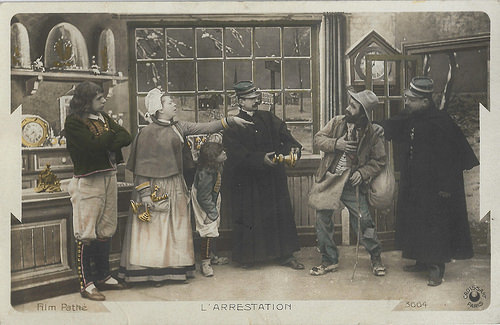
French postcard by Croissant, Paris, no. 3664. Photo: Film Pathé. Still for Le chemineau/The Tramp (Albert Capellani, 1905). Arrested at a jeweller, to whom he tries to sell his loot, the gendarmes bring him back to the pastor.
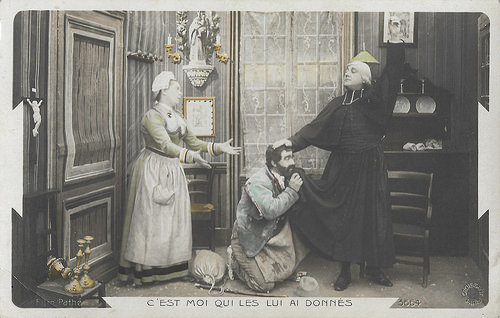
French postcard by Croissant, Paris, no. 3664. Photo: Film Pathé. Still for Le chemineau/The Tramp (Albert Capellani, 1905). Despite all, the pastor wants to exonerate the miserable man's soul and tells a lie to the gendarmes: I gave the objects myself to him. The thief repents.
Le chemineau (Albert Capellani, 1905). Source: History VA (YouTube). The last part of the film is missing.
Sources: Richard Abel ('Capellani avant Griffith, 1906-1908', 1895, 68, 2012, p. 15), Fondation Jerome Seydoux (French), Wikipedia (French and English) and .

French postcard by Croissant, Paris, no. 3664. Photo: Film Pathé. Still for Le chemineau/The Tramp (Albert Capellani, 1905). It's winter, snow falls on the desolate countryside. An exhausted tramp asks in vain for an alimony from passers-by.

French postcard by Croissant, Paris, no. 3664. Photo: Film Pathé. Still for Le chemineau/The Tramp (Albert Capellani, 1905). The tramp presents himself at the presbyterium and is hosted by the pastor, who lets him dine at his table and sleep in his bed, while he himself sleeps in his chair.
Les Miserables in five minutes
Director Albert Capellani was a neglected but important film pioneer. Recent retrospectives of his restored films, e.g. at Cinema Ritrovato in Bologna in 2012, and special DVD editions attest to Capellani's contribution in the use of deep staging shots, various changes in framing and even rudimentary editing techniques.
Capellani, born in 1874 in Paris, directed films between 1905 and 1922. One of his brothers was the actor-sculptor Paul Capellani . Albert studied acting under Charles le Bargy at the Conservatoire de Paris. Starting his career as an actor, he worked with the director André Antoine at the Théâtre Libre and the Odéon. He then began directing plays for the Odéon, working alongside renowned actor and director Firmin Gémier. In 1903, he became the head of the Alhambra music hall in Paris. He continued to work as an actor and director until he received a job offer from the Pathé Frères studio in 1905.
For Pathé Frères, Albert Capellani tended to specialise in several genres: costume dramas with historical and biblical themes, fables, fantastic adventures and melodramas often based on famous novels. Le Chemineau/The Tramp (1905), one of his first films, was such a melodrama. In 5 minutes, it stages an episode from Les Miserables by Victor Hugo in which Jean Valjean, who is granted lodging by mr. Myriel, the parish priest of a village, steals several silver candlesticks and escapes the arrest thanks to the false testimony of the priest. In the US Le Chemineau premiered in 1906 and was inappropriately titled The Strong Arm of the Law.
Richard Abel in his article Capellani avant Griffith, 1906-1908 in The Ciné Goes to Town : French Cinema, 1896-1914: "The film mainly uses the usual representation system of the beginnings of the cinema: its six exhibition boards, the majority of which consist of long shots, were filmed in studio with decorations painted on panels for indoor and outdoor scenes. The first two paintings, for example, depict a winter landscape with a small village (church included) visible in the distance, in the background, while in the foreground, the tired silhouette of Jean Valjean staggers in the falling snow."
However, Abel sees at least three occurrences of unusual framing or editing choices: "What is particularly surprising, in the very first painting, is to see Valjean arrive thanks to an unexpected big plan that not only serves to catch the spectator but also to describe briefly the character, emphasizing his disillusioned gaze, his sad mouth and ragged appearance. After being rejected by a series of peasants on his way and facing a woman opening the door where he just knocked, Valjean appears in front of the presbytery door and is invited by a maid to enter a small room where the priest is seated at the table. This scene follows its movement through a sequence of exterior and interior shots, from one side of the door (on the right of the screen) to the other (on the left of the screen)."
"When the servant surprises him with a plate of food in her hand, a horizontal panning to the right reveals an adjoining room where the priest and the maid lead him to spend the night. This sequence continues, while he discovers, in the background, a cupboard filled with silverware, stuffs the candlesticks in a bag and, in a reverse plane of horizontal panning to the left, goes on tiptoe in front of the priest asleep in the first room and go out the door. Only one of the two final plans has been preserved: the picture of the interior of a shop where Valjean pledges candlesticks, the maid, unsure of nothing, enters and is shocked to see them; the gendarmes stop him. The final painting apparently brings the viewer back into the priest's room, but probably without the need for a similar panoramic view, when the latter declares to the gendarmes, against all odds, in a recreated intertitle: 'Let this man go, I gave him the candlesticks'."
Richard Abel concludes: "During this period of transformation (c. 1906-1908), Capellani and his fellow directors at Pathé Frères, but also Alice Guy and especially Louis Feuillade at Gaumont, successfully tested many narrative and representative strategies that would characterize the narrative discourse of French cinema during the most most of the 1910s. The American filmmakers, first at Vitagraph, then at Biograph, where D.W. Griffith began shooting films in the summer of 1908, would develop them even more and lay the groundwork for what would be called later 'Hollywood classic cinema'. Although there is little direct evidence, French films, particularly those of Capellani, most likely have had a strong impact on American cinema as they were widely distributed and screened in the United States. Pathé films not only served to close the variety shows in hundreds of theaters, they also formed the main entertainment of the Nickelodeon, a new kind of theaters, which quickly counted by the thousands from early 1907 onwards."
Albert Capellani made a feature-length version of Les Miserables in 1912. He worked in the US from 1914 to 19 22, under contract to Metro, wheren he frequently directed Alla Nazimova and Clara Kimball Young. Then he stopped with film making and returned to Paris. There he died in 1931, neglected and only 57 years old. The film director Roger Capellani was his son.

French postcard by Croissant, Paris, no. 3664. Photo: Film Pathé. Still for Le chemineau/The Tramp (Albert Capellani, 1905). At night, the tramp sees golden objects that serve for mass in a cupboard in the bedroom. He sticks them in his bag and secretly sneaks away, trying not to awake the pastor.

French postcard by Croissant, Paris, no. 3664. Photo: Film Pathé. Still for Le chemineau/The Tramp (Albert Capellani, 1905). Arrested at a jeweller, to whom he tries to sell his loot, the gendarmes bring him back to the pastor.

French postcard by Croissant, Paris, no. 3664. Photo: Film Pathé. Still for Le chemineau/The Tramp (Albert Capellani, 1905). Despite all, the pastor wants to exonerate the miserable man's soul and tells a lie to the gendarmes: I gave the objects myself to him. The thief repents.
Le chemineau (Albert Capellani, 1905). Source: History VA (YouTube). The last part of the film is missing.
Sources: Richard Abel ('Capellani avant Griffith, 1906-1908', 1895, 68, 2012, p. 15), Fondation Jerome Seydoux (French), Wikipedia (French and English) and .
Published on October 17, 2018 22:00
October 16, 2018
Christiane Hörbiger
Christiane Hörbiger (1938) is an Austrian television and film actress, born into a well-known actors family. Since 1955, she made a name for herself on stage and television and in several films.
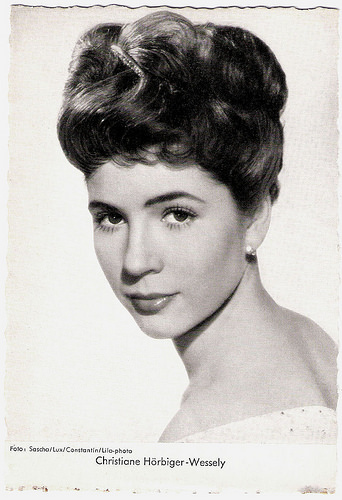
German postcard by WS-Druck, Wanne-Eickel. Photo: Sascha-Lux / Constantin / Lilo. Publicity still for Kronprinz Rudolfs letzte Liebe/Mayerling (Rudolf Jugert, 1956).

German postcard by Rüdel-Verlag, Hamburg-Bergedorf, no. 1617. Photo: Sascha-Lux / Constantin / Lilo. Publicity still for Kronprinz Rudolfs letzte Liebe/Mayerling (Rudolf Jugert, 1956).
No doubt whose offspring she was
Christiane Hörbiger was born in 1938 in Vienna, Austria. She is one of the three actress daughters of the famous Austrian actors Attila Hörbiger and Paula Wessely . Her uncle is the equally known Paul Hörbiger . Her sisters are Elisabeth Orth and Maresa Hörbiger, and she is also the aunt of German-Austrian actor Christian Tramitz.
Christiane made her film debut in the female lead of Der Major und die Stiere/The Major and the Steers (Eduard von Borsody, 1955) with Fritz Tillmann and her father Attila Hörbiger .
She started to study acting at the Max-Reinhardt-Seminar, but broke off her studies when she received another offer for a film role. She played with her mother Paula Wessely in Die Wirtin zur Goldenen Krone/The landlady of the Golden Crown (Theo Lingen, 1955).
In the historical drama Kronprinz Rudolfs letzte Liebe/Mayerling (Rudolf Jugert, 1956), she then played Baroness Marie Vetsera opposite Rudolf Prack as Crown Prince Rudolf. She was credited as Christiane Hörbiger-Wessely. The director insisted that Christiane Hörbiger used both her parents' names (Wessely and Hörbiger) to leave the audience no doubt whose offspring she was.
For Jugert, she also appeared in the Heimat drama Der Meineidbauer/The Perjurer (Rudolf Jugert, 1956) with Carl Wery and Heidemarie Hatheyer . Another Heimat drama was Der Edelweißkönig (Gustav Ucicky, 1957) with Rudolf Lenz. She played a supporting part in the comedy Immer die Radfahrer/Always the cyclists (Hans Deppe, 1958) with Heinz Erhardt.
Her stage debut in 1959 as Recha in Lessings Nathan der Weise at the Burgtheater, was not a success. From 1960 till 1961, she played at the Städtischen Bühnen Heidelberg, and from 1961 till 1966 she was back in Vienna at the Burgtheater. Later she played several important stage roles at the Schauspielhaus Zürich.
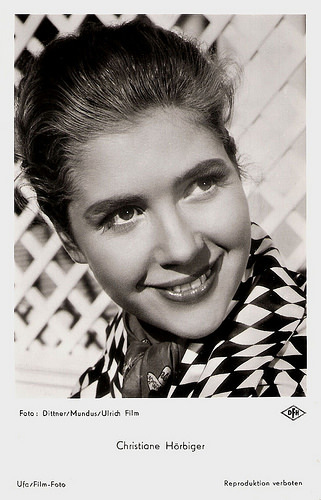
German postcard by Ufa/Film-Foto, no. FK 4242. Photo: Dittner / Mundus / Ulrich Film / DFH. Publicity still for Immer die Radfahrer/Always the cyclists (Hans Deppe, 1958).
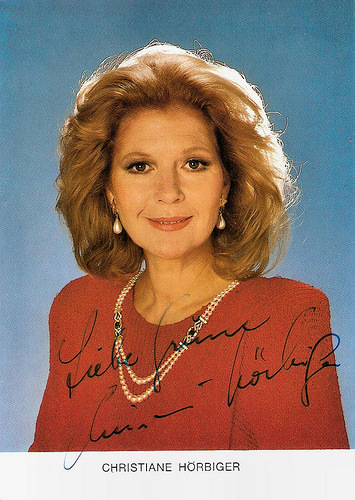
German postcard by Rüdel-Verlag, Hamburg. Photo: Winfried Rabanus, München.
I am the White Clown
From 1960 on, Christiane Hörbiger played in various German and Austrian TV films and series. Incidentally, she appeared in such feature films as the fantasy Der Bauer als Millionär/The Farmer as Millionaire (Alfred Stöger, Rudolf Steinboeck, 1961) with Käthe Gold , the fairy-tale Der Verschwender/The Wasteful (Kurt Meisel, 1964) with Walther Reyer , and Versuchung im Sommerwind/Temptation in the Summer Wind (Rolf Thiele, 1972) as the assistant of Helmut Käutner .
She played the lead in the popular TV series Das Erbe der Guldenburgs/The Legacy of the Guldenburgs (Jürgen Goslar, Gero Erhardt, 1987-1990) about an aristocratic German family (The Guldenburgs) and the various relationships and problems the family goes through. The success of the series caused a second start of her career.
In the 1990s, she returned to the cinema in films such as the comedy Schtonk (Helmut Dietl, 1992), the slightly fictionalised story of an art forger (Uwe Ochsenknecht), a journalist desperate for a big story ( Götz George ), and the biggest press scandal in German history: the Hitler Diaries.
From 1998 until 2002, she played the eponymous role in the Austrian TV series Julia - eine ungewöhnliche Frau/Julia - An Extraordinary Woman. In 1995, she was a member of the jury at the 45th Berlin International Film Festival.
Hörbiger keeps working for television. Her most recent feature film is the crime comedy Mean Parents Suck (William Shepherd, 2010) in which she played a Kindergarten teacher who kills mean parents. Her only foray so far into voice acting has been the role of Mrs. Caloway (the dairy cow) in the German-language version of Disney's Home on the Range (Will Finn, John Sanford, 2004).
Christiane Hörbiger was married twice: from 1962 till 1967 to director Wolfgang Glück and later to Swiss journalist Rolf R. Bigler. From this marriage comes the son Sascha Bigler (1968), who she raised alone after the death of her husband. Sascha Bigler lives in Los Angeles today and works as a director. Her later partner was Gerhard Tötschinger. From 1984 until his death in 2016, the couple lived alternately in Vienna, Baden near Vienna and Zurich.
In 2008 Christiane Hörbiger published her autobiography Ich bin der Weiße Clown (I am the White Clown). She won many awards. In 2001, she received Germany's most important medal, the Bundesverdienstkreuz. In 2004, she was awarded as Kammerschauspielerin in Austria.
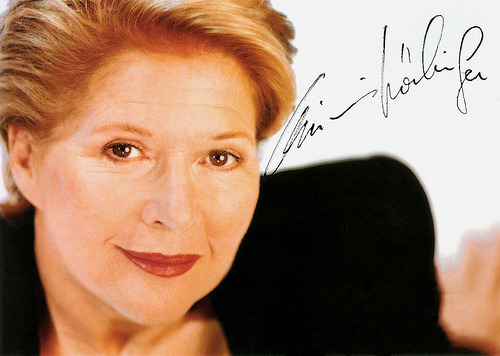
German autograph card by Rüdel-Verlag, Hamburg. Photo: Werner Grecht, Wien.
Sources: Wikipedia (German and English) and .

German postcard by WS-Druck, Wanne-Eickel. Photo: Sascha-Lux / Constantin / Lilo. Publicity still for Kronprinz Rudolfs letzte Liebe/Mayerling (Rudolf Jugert, 1956).

German postcard by Rüdel-Verlag, Hamburg-Bergedorf, no. 1617. Photo: Sascha-Lux / Constantin / Lilo. Publicity still for Kronprinz Rudolfs letzte Liebe/Mayerling (Rudolf Jugert, 1956).
No doubt whose offspring she was
Christiane Hörbiger was born in 1938 in Vienna, Austria. She is one of the three actress daughters of the famous Austrian actors Attila Hörbiger and Paula Wessely . Her uncle is the equally known Paul Hörbiger . Her sisters are Elisabeth Orth and Maresa Hörbiger, and she is also the aunt of German-Austrian actor Christian Tramitz.
Christiane made her film debut in the female lead of Der Major und die Stiere/The Major and the Steers (Eduard von Borsody, 1955) with Fritz Tillmann and her father Attila Hörbiger .
She started to study acting at the Max-Reinhardt-Seminar, but broke off her studies when she received another offer for a film role. She played with her mother Paula Wessely in Die Wirtin zur Goldenen Krone/The landlady of the Golden Crown (Theo Lingen, 1955).
In the historical drama Kronprinz Rudolfs letzte Liebe/Mayerling (Rudolf Jugert, 1956), she then played Baroness Marie Vetsera opposite Rudolf Prack as Crown Prince Rudolf. She was credited as Christiane Hörbiger-Wessely. The director insisted that Christiane Hörbiger used both her parents' names (Wessely and Hörbiger) to leave the audience no doubt whose offspring she was.
For Jugert, she also appeared in the Heimat drama Der Meineidbauer/The Perjurer (Rudolf Jugert, 1956) with Carl Wery and Heidemarie Hatheyer . Another Heimat drama was Der Edelweißkönig (Gustav Ucicky, 1957) with Rudolf Lenz. She played a supporting part in the comedy Immer die Radfahrer/Always the cyclists (Hans Deppe, 1958) with Heinz Erhardt.
Her stage debut in 1959 as Recha in Lessings Nathan der Weise at the Burgtheater, was not a success. From 1960 till 1961, she played at the Städtischen Bühnen Heidelberg, and from 1961 till 1966 she was back in Vienna at the Burgtheater. Later she played several important stage roles at the Schauspielhaus Zürich.

German postcard by Ufa/Film-Foto, no. FK 4242. Photo: Dittner / Mundus / Ulrich Film / DFH. Publicity still for Immer die Radfahrer/Always the cyclists (Hans Deppe, 1958).

German postcard by Rüdel-Verlag, Hamburg. Photo: Winfried Rabanus, München.
I am the White Clown
From 1960 on, Christiane Hörbiger played in various German and Austrian TV films and series. Incidentally, she appeared in such feature films as the fantasy Der Bauer als Millionär/The Farmer as Millionaire (Alfred Stöger, Rudolf Steinboeck, 1961) with Käthe Gold , the fairy-tale Der Verschwender/The Wasteful (Kurt Meisel, 1964) with Walther Reyer , and Versuchung im Sommerwind/Temptation in the Summer Wind (Rolf Thiele, 1972) as the assistant of Helmut Käutner .
She played the lead in the popular TV series Das Erbe der Guldenburgs/The Legacy of the Guldenburgs (Jürgen Goslar, Gero Erhardt, 1987-1990) about an aristocratic German family (The Guldenburgs) and the various relationships and problems the family goes through. The success of the series caused a second start of her career.
In the 1990s, she returned to the cinema in films such as the comedy Schtonk (Helmut Dietl, 1992), the slightly fictionalised story of an art forger (Uwe Ochsenknecht), a journalist desperate for a big story ( Götz George ), and the biggest press scandal in German history: the Hitler Diaries.
From 1998 until 2002, she played the eponymous role in the Austrian TV series Julia - eine ungewöhnliche Frau/Julia - An Extraordinary Woman. In 1995, she was a member of the jury at the 45th Berlin International Film Festival.
Hörbiger keeps working for television. Her most recent feature film is the crime comedy Mean Parents Suck (William Shepherd, 2010) in which she played a Kindergarten teacher who kills mean parents. Her only foray so far into voice acting has been the role of Mrs. Caloway (the dairy cow) in the German-language version of Disney's Home on the Range (Will Finn, John Sanford, 2004).
Christiane Hörbiger was married twice: from 1962 till 1967 to director Wolfgang Glück and later to Swiss journalist Rolf R. Bigler. From this marriage comes the son Sascha Bigler (1968), who she raised alone after the death of her husband. Sascha Bigler lives in Los Angeles today and works as a director. Her later partner was Gerhard Tötschinger. From 1984 until his death in 2016, the couple lived alternately in Vienna, Baden near Vienna and Zurich.
In 2008 Christiane Hörbiger published her autobiography Ich bin der Weiße Clown (I am the White Clown). She won many awards. In 2001, she received Germany's most important medal, the Bundesverdienstkreuz. In 2004, she was awarded as Kammerschauspielerin in Austria.

German autograph card by Rüdel-Verlag, Hamburg. Photo: Werner Grecht, Wien.
Sources: Wikipedia (German and English) and .
Published on October 16, 2018 22:00
Paul van Yperen's Blog
- Paul van Yperen's profile
- 13 followers
Paul van Yperen isn't a Goodreads Author
(yet),
but they
do have a blog,
so here are some recent posts imported from
their feed.



